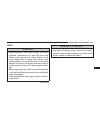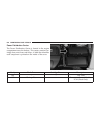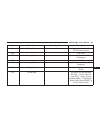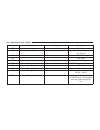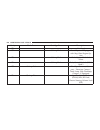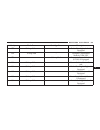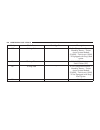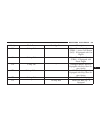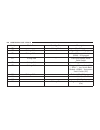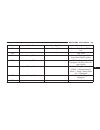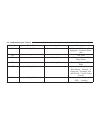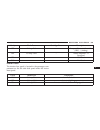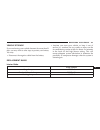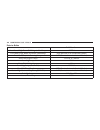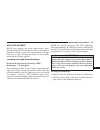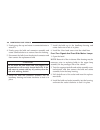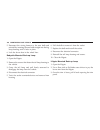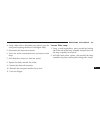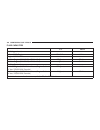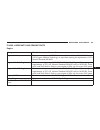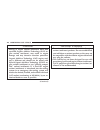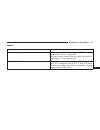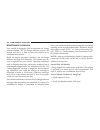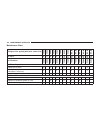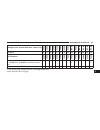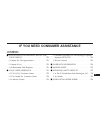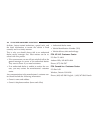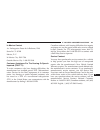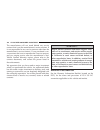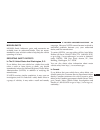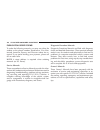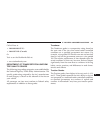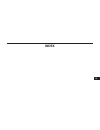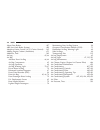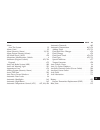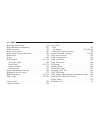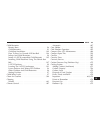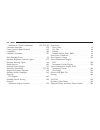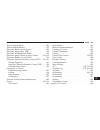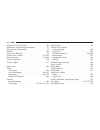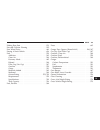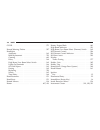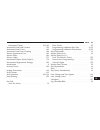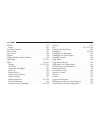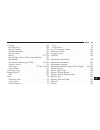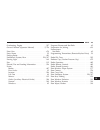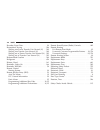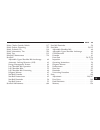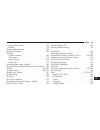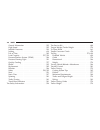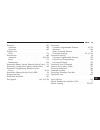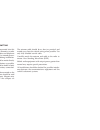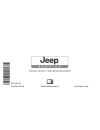- DL manuals
- Jeep
- Automobile
- 2015 Cherokee
- Owner's Manual
Jeep 2015 Cherokee Owner's Manual
Summary of 2015 Cherokee
Page 1
Cherokee o w n e r ’ s m a n u a l 20 15 cher ok ee 15kl74-126-ad fourth edition rev 2 printed in u.S.A. 2 0 1 5 fca us llc.
Page 2
Vehicles sold in canada with respect to any vehicles sold in canada, the name fca us llc shall be deemed to be deleted and the name fca canada inc. Used in substitution therefore. Driving and alcohol drunken driving is one of the most frequent causes of accidents. Your driving ability can be serious...
Page 3: Table Of Contents
Table of contents section page 1 introduction . . . . . . . . . . . . . . . . . . . . . . . . . . . . . . . . . . . . . . . . . . . . . . . . . . . . . . . . . . . . . . . 3 2 things to know before starting your vehicle . . . . . . . . . . . . . . . . . . . . . . . . . . . . . . . . . . 9 3 understa...
Page 5: Introduction
Introduction contents 䡵 introduction . . . . . . . . . . . . . . . . . . . . . . . .4 䡵 rollover warning . . . . . . . . . . . . . . . . . . .4 䡵 how to use this manual . . . . . . . . . . . . . .5 䡵 warnings and cautions . . . . . . . . . . . . . .7 䡵 vehicle identification number . . . . . . . .7 ...
Page 6
Introduction congratulations on selecting your new fca us llc vehicle. Be assured that it represents precision workman- ship, distinctive styling, and high quality - all essentials that are traditional to our vehicles. This owner’s manual has been prepared with the assis- tance of service and engine...
Page 7
Control. Failure to operate this vehicle safely may result in a collision, rollover of the vehicle, and severe or fatal injury. Drive carefully. Failure to use the driver and passenger seat belts pro- vided is a major cause of severe or fatal injury. In fact, the u.S. Government notes that the unive...
Page 8
6 introduction.
Page 9
Warnings and cautions this owners manual contains warnings against op- erating procedures that could result in a collision or bodily injury. It also contains cautions against proce- dures that could result in damage to your vehicle. If you do not read this entire owner’s manual, you may miss importa...
Page 10
Note: it is illegal to remove or alter the vin. Vehicle modifications/alterations warning! Any modifications or alterations to this vehicle could seriously affect its roadworthiness and safety and may lead to a collision resulting in serious injury or death. Right front body vin location 8 introduct...
Page 11: Contents
Things to know before starting your vehicle contents 䡵 a word about your keys . . . . . . . . . . . . .12 ▫ ignition node module (ignm) — if equipped. .12 ▫ keyless ignition node (kin) . . . . . . . . . . . . . .13 ▫ key fob — if equipped . . . . . . . . . . . . . . . . . .14 ▫ ignition or accessory...
Page 12
▫ transmitter battery replacement . . . . . . . . . . .25 ▫ general information . . . . . . . . . . . . . . . . . . . .29 䡵 remote starting system — if equipped . .30 ▫ how to use remote start . . . . . . . . . . . . . . . .30 ▫ remote start abort message on electronic vehicle information center (ev...
Page 13
▫ seat belt systems . . . . . . . . . . . . . . . . . . . . . .54 ▫ supplemental restraint system (srs) . . . . . . . .65 ▫ child restraints . . . . . . . . . . . . . . . . . . . . . . .91 ▫ transporting pets . . . . . . . . . . . . . . . . . . . . .112 䡵 engine break-in recommendations . . .112 䡵 s...
Page 14
A word about your keys your vehicle uses either a key start ignition system or keyless ignition system. The key start ignition system consists of a either a key fob with remote keyless entry (rke) transmitter and an ignition node module (ignm). The keyless ignition system consists of a key fob with ...
Page 15
Keyless ignition node (kin) this feature allows the driver to operate the ignition with the push of a button as long as the remote keyless entry (rke) transmitter is in the passenger compartment. The keyless ignition node (kin system) has four oper- ating positions, three of which are labeled and wi...
Page 16
Key fob — if equipped the key fob also contains the remote keyless entry (rke) transmitter and an emergency key, which stores in the rear of the key fob. The emergency key allows for entry into the vehicle should the battery in the vehicle or the key fob go dead. You can keep the emergency key with ...
Page 17
Note: you can insert the double-sided emergency key into the lock cylinders with either side up. Ignition or accessory on message when opening the driver’s door when the ignition is in acc or on/run (engine not running), a chime will sound to remind you to place the ignition in the off position. In ...
Page 18
Warning! • when leaving the vehicle, always remove the key fob from the vehicle and lock your vehicle. • never leave children alone in a vehicle, or with access to an unlocked vehicle. • allowing children to be in a vehicle unattended is dangerous for a number of reasons. A child or others could be ...
Page 19
The system uses a key fob with a factory-mated remote keyless entry (rke) transmitter, a keyless ignition node (kin) and a rf receiver to prevent unauthorized vehicle operation. Therefore, only key fobs that are pro- grammed to the vehicle can be used to start and operate the vehicle. The system wil...
Page 20
Replacement keys note: only key fobs that are programmed to the vehicle electronics can be used to start and operate the vehicle. Once a key fob is programmed to a vehicle, it cannot be programmed to any other vehicle. Caution! • always remove the key fobs from the vehicle and lock all doors when le...
Page 21
Note: changes or modifications not expressly approved by the party responsible for compliance could void the user’s authority to operate the equipment. Vehicle security alarm — if equipped the vehicle security alarm monitors the vehicle doors for unauthorized entry and the keyless enter-n-go™ start/...
Page 22
2. Perform one of the following methods to lock the vehicle: • push lock on the interior power door lock switch with the driver and/or passenger door open. • push the lock button on the exterior passive entry door handle with a valid key fob available in the same exterior zone (refer to ⬙ keyless en...
Page 23
• for vehicles not equipped with keyless enter-n- go™, insert a valid key into the ignition switch and turn the key to the on position. Note: • the driver’s door key cylinder and the liftgate button on the rke transmitter cannot arm or disarm the vehicle security alarm. • the vehicle security alarm ...
Page 24
Security system manual override the vehicle security alarm will not arm if you lock the doors using the manual door lock plunger. Illuminated entry the courtesy lights will turn on when you use the remote keyless entry (rke) transmitter to unlock the doors or open any door. This feature also turns o...
Page 25
Remote keyless entry (rke) to unlock the doors and liftgate push and release the unlock button on the rke transmitter once to unlock the driver’s door or twice within five seconds to unlock all doors and liftgate. The turn signal lights will flash to acknowledge the unlock signal. The illuminated en...
Page 26
If the vehicle is equipped with passive entry, refer to “keyless enter-n-go™” in “things to know before starting your vehicle” for further information. 1st push of key fob unlocks this feature lets you program the system to unlock either the driver’s door or all doors on the first push of the unlock...
Page 27
Sound horn with lock this feature will cause the horn to chirp when the doors are locked with the rke transmitter. This feature can be turned on or turned off. To change the current setting, refer to “uconnect® settings” in “understanding your instrument panel” for further information. Using the pan...
Page 28
Note: • perchlorate material — special handling may apply. See www.Dtsc.Ca.Gov/hazardouswaste/perchlorate • do not touch the battery terminals that are on the back housing or the printed circuit board. 1. Remove the emergency key by sliding the mechanical latch on the back of the rke transmitter sid...
Page 29
2. Separating rke halves requires screw removal (if equipped) and gently prying the two halves of the rke transmitter apart with the emergency key. Make sure not to damage the seal during removal. Emergency key removal (kin) remove screw from transmitter case 2 things to know before starting your ve...
Page 30
Separating ignition node module (ignm) transmitter case separating keyless ignition node (kin) transmitter case 28 things to know before starting your vehicle.
Page 31
3. Remove the battery by turning the back cover over (battery facing downward) and tapping it lightly on a solid surface such as a table or similar, and then replace the battery. When replacing the battery, match the + sign on the battery to the + sign on the inside of the battery clip, located on t...
Page 32
Remote starting system — if equipped this system uses the remote keyless entry (rke) transmitter to start the engine conve- niently from outside the vehicle while still maintaining security. The system has a range of approximately 300 ft (91 m). Note: • the vehicle must be equipped with an automatic...
Page 33
Warning! • do not start or run an engine in a closed garage or confined area. Exhaust gas contains carbon mon- oxide (co) which is odorless and colorless. Carbon monoxide is poisonous and can cause serious in- jury or death when inhaled. • keep remote keyless entry (rke) transmitters away from child...
Page 34
To enter remote start mode push and release the remote start button on the rke transmitter twice within five sec- onds. The vehicle doors will lock, the parking lights will flash, and the horn will chirp twice (if programmed). Then, the engine will start, and the vehicle will remain in the remote st...
Page 35
Doors and disarm the vehicle security alarm (if equipped). Then, prior to the end of the 15-minute cycle, push and release the start/stop button. If the start/ stop button is not present, insert the key fob into the ignition switch and turn the switch to the on/run position. Note: • for vehicles not...
Page 36
Remote start windshield wiper de–icer activation — if equipped when remote start is active and the outside ambient temperature is less than 33° f (.5° c), the windshield wiper de-icer will be enabled. Exiting remote start will resume previous operation, except if the windshield wiper de-icer is acti...
Page 37
Warning! (continued) be in a vehicle unattended is dangerous for a number of reasons. A child or others could be seriously or fatally injured. Children should be warned not to touch the parking brake, brake pedal or the gear selector. • do not leave the key fob in or near the vehicle, or in a locati...
Page 38
Is open, the power locks will not operate. This prevents you from accidentally locking the key fob in the vehicle. Placing the ignition to the off position or closing the door will allow the locks to operate. If a door is open, and the ignition is in the acc or on/run position, a chime will sound as...
Page 39
Child-protection door lock system — rear doors to provide a safer environment for small children riding in the rear seats, the rear doors are equipped with a child-protection door lock system. To use the system, open each rear door, use a flat blade screwdriver (or ignition key) and rotate the dial ...
Page 40
Note: • when the child lock system is engaged, the door can be opened only by using the outside door handle even though the inside door lock is in the unlocked position. • after disengaging the child-protection door lock system, always test the door from the inside to make certain it is in the desir...
Page 41
• if wearing gloves on your hands, or if it has been raining on the passive entry door handle, the unlock sensitivity can be affected, resulting in a slower re- sponse time. • if the vehicle is unlocked by the passive entry door handle, and no door goes ajar within 60 seconds, the vehicle will re-lo...
Page 42
To unlock from the passenger side with a valid passive entry rke transmitter within 5 ft (1.5 m) of the passenger door handle, grab the front passenger door handle to unlock all four doors and the liftgate automatically. Note: all doors will unlock when the front passenger door handle is grabbed reg...
Page 43
Note: the vehicle will only unlock the doors when a valid passive entry rke transmitter is detected inside the vehicle, and no valid passive entry rke transmitter is detected outside the vehicle. The vehicle will not unlock the doors when any of the following conditions are true: • the doors are man...
Page 44
To lock the liftgate with a valid passive entry rke transmitter within 3 ft (1.0 m) of the liftgate, push the passive entry lock button located to the right of electronic liftgate release. Note: the liftgate passive entry lock button will lock all doors and the liftgate. The liftgate unlock feature ...
Page 45
To lock the vehicle’s doors and liftgate with one of the vehicle’s passive entry rke transmitters within 5 ft (1.5 m) of the driver or passenger front door handles, push the door handle lock button to lock all four doors. Do not grab the door handle, when pushing the door handle lock button. This co...
Page 46
Note: • after pushing the door handle button, you must wait two seconds before you can lock or unlock the doors, using either passive entry door handle. This is done to allow you to check if the vehicle is locked by pulling the door handle without the vehicle reacting and unlocking. • if passive ent...
Page 47
Windows power windows the window controls on the driver’s door control all the door windows. There are single window controls on each passenger door trim panel, which operate the passenger door windows. The window controls will operate only when the ignition is in the acc or on/run position. Note: f...
Page 48
To open the window part way, push the window switch to the first detent and release it when you want the window to stop. To stop the window from going all the way down during the auto-down operation, pull up on the switch briefly. Auto-up feature with anti-pinch protection lift the window switch to ...
Page 49
Reset auto-up should the auto up feature stop working, the window probably needs to be reset. To reset auto up: 1. Pull the window switch up to close the window completely and continue to hold the switch up for an additional two seconds after the window is closed. 2. Push the window switch down firm...
Page 50
Liftgate to unlock/enter the liftgate the liftgate passive entry unlock feature is built into the electronic liftgate release. With a valid passive entry rke transmitter within 3 ft (1.0 m) of the liftgate, push the electronic liftgate release to open with one fluid motion. Note: if “unlock all door...
Page 51
Note: use the power door lock switch on either front door trim panel or the remote keyless entry (rke) transmitter to lock and unlock the liftgate. The manual door locks on the doors and the driver’s door lock cylinder will not lock and unlock the liftgate. Warning! Driving with the liftgate open ca...
Page 52
The power liftgate may also be opened or closed by pushing the liftgate button located on the left side of the steering wheel on the instrument panel, or closed by pushing the liftgate button located on left rear trim panel, near the liftgate opening. Push the liftgate button located on left rear tr...
Page 53
Note: • the power liftgate will not operate in temperatures below −22°f (−30°c) or temperatures above 150°f (65°c). Be sure to remove any buildup of snow or ice from the liftgate before pushing any of the power liftgate switches. • if anything obstructs the power liftgate while it is closing or open...
Page 54
Warning! • driving with the liftgate open can allow poisonous exhaust gases into your vehicle. You and your passengers could be injured by these fumes. Keep the liftgate closed when you are operating the vehicle. • if you are required to drive with the liftgate open, make sure that all windows are c...
Page 55
Restraints or belt-positioning booster seats. Older chil- dren who do not use child restraints or belt- positioning booster seats should ride properly buckled up in a vehicle with a rear seat. 4. Never allow children to slide the shoulder belt behind them or under their arm. 5. You should read the i...
Page 56
Seat belt systems buckle up even though you are an excellent driver, even on short trips. Someone on the road may be a poor driver and could cause a collision that includes you. This can happen far away from home or on your own street. Research has shown that seat belts save lives, and they can redu...
Page 57
Beltalert may be triggered when an animal or heavy object is on the outboard front passenger seat or when the seat is folded flat (if equipped). It is recommended that pets be restrained in the rear seat (if equipped) in pet harnesses or pet carriers that are secured by seat belts, and cargo is prop...
Page 58
Warning! (continued) • in a collision, you and your passengers can suffer much greater injuries if you are not properly buck- led up. You can strike the interior of your vehicle or other passengers, or you can be thrown out of the vehicle. Always be sure you and others in your vehicle are buckled up...
Page 59
Warning! (continued) • a twisted seat belt may not protect you properly. In a collision, it could even cut into you. Be sure the seat belt is flat against your body, without twists. If you can’t straighten a seat belt in your vehicle, take it to your authorized dealer immediately and have it fixed. ...
Page 60
Warning! (continued) frays, or loose parts. Damaged parts must be re- placed immediately. Do not disassemble or modify the seat belt system. Seat belt assemblies must be replaced after a collision. Lap/shoulder belt operating instructions 1. Enter the vehicle and close the door. Sit back and adjust ...
Page 61
3. When the seat belt is long enough to fit, insert the latch plate into the buckle until you hear a “click.” 4. Position the lap belt so that it is snug and lies low across your hips, below your abdomen. To remove slack in the lap belt portion, pull up on the shoulder belt. To loosen the lap belt i...
Page 62
6. To release the seat belt, push the red button on the buckle. The seat belt will automatically retract to its stowed position. If necessary, slide the latch plate down the webbing to allow the seat belt to retract fully. Lap/shoulder belt untwisting procedure use the following procedure to untwist...
Page 63
As a guide, if you are shorter than average, you will prefer the shoulder belt anchorage in a lower position, and if you are taller than average, you will prefer the shoulder belt anchorage in a higher position. After you release the anchorage button, try to move it up or down to make sure that it i...
Page 64
Warning! • only use a seat belt extender if it is physically required in order to properly fit the original seat belt system. Do not use the seat belt extender if, when worn, the distance between the front edge of the seat belt extender buckle and the center of the occupant’s body is less than 6 inc...
Page 65
The pretensioners are triggered by the occupant re- straint controller (orc). Like the air bags, the preten- sioners are single use items. A deployed pretensioner or a deployed air bag must be replaced immediately. Energy management feature this vehicle has a seat belt system with an energy manageme...
Page 66
If the passenger seating position is equipped with an alr and is being used for normal usage: only pull the seat belt webbing out far enough to comfortably wrap around the occupant’s mid-section so as to not activate the alr. If the alr is activated, you will hear a clicking sound as the seat belt r...
Page 67
3. Allow the seat belt to retract. As the seat belt retracts, you will hear a clicking sound. This indicates the seat belt is now in the automatic locking mode. How to disengage the automatic locking mode unbuckle the combination lap/shoulder belt and allow it to retract completely to disengage the ...
Page 68
• steering wheel and column • instrument panel • knee impact bolsters • advanced front air bags • supplemental side air bags • supplemental knee air bags • front and side impact sensors • seat belt pretenioners • seat belt buckle switch • seat track position sensors • occupant classification system ...
Page 69
Warning! • being too close to the steering wheel or instrument panel during advanced front air bag deployment could cause serious injury, including death. Air bags need room to inflate. Sit back, comfortably extending your arms to reach the steering wheel or instrument panel. • never place a rear-fa...
Page 70
Advanced front air bag features the advanced front air bag system has multistage driver and front passenger air bags. This system provides output appropriate to the severity and type of collision as determined by the occupant restraint controller (orc), which may receive information from the front i...
Page 71
Warning! (continued) • do not put anything on or around the air bag covers or attempt to open them manually. You may damage the air bags and you could be injured because the air bags may no longer be functional. The protective covers for the air bag cushions are designed to open only when the air ba...
Page 72
Seat belts are necessary for your protection in all colli- sions, and also are needed to help keep you in position, away from an inflating air bag. When the orc detects a collision requiring the ad- vanced front air bags, it signals the inflator units. A large quantity of non-toxic gas is generated ...
Page 73
Occupant classification module (ocm) and sensor the occupant classification module (ocm) is located underneath the front passenger seat. The sensor is lo- cated beneath the passenger seat cushion foam. Any weight on the seat will be sensed by the sensor. The ocm uses input from the sensor to determi...
Page 74
Front passenger seat occupant status front passenger air bag output rear-facing child restraint reduced-power deployment child, including a child in a forward-facing child restraint or booster seat* reduced-power deployment or full- power deployment properly seated adult full-power deployment or red...
Page 75
In order for the ocs to operate as designed, it is important for the front passenger to be seated properly and properly wearing the seat belt. Properly seated passengers are: • sitting upright • facing forward • sitting in the center of the seat with their feet comfort- ably on or near the floor • s...
Page 76
Lighter weight passengers (including small adults) when a lighter weight passenger, including a small adult, occupies the front passenger seat, the ocs may reduce the inflation rate of the passenger advanced front air bag. This does not mean that the ocs is working improperly. Do not decrease or inc...
Page 77
• the front passenger carries or holds an object while seated (e.G., backpack, box, etc.) • objects are lodged under the front passenger seat. • objects are lodged between the front passenger seat and center console. • accessories that may change the seated weight on the front passenger seat are att...
Page 78
Not seated properly not seated properly 76 things to know before starting your vehicle.
Page 79
Warning! • if an occupant in the front passenger seat is seated improperly, the occupant may provide an output signal to the ocs that is different from the occu- pant’s properly seated weight input. This may result in serious injury or death in a collision. • always wear your seat belt and sit prope...
Page 80
Warning! (continued) • placing an object on the floor under the front passenger seat may prevent the ocs from working properly, which may result in serious injury or death in a collision. Do not place any objects on the floor under the front passenger seat. The air bag warning light will turn on whe...
Page 81
• do not add a secondary seat cover or mat. • at no time should any supplemental restraint system (srs) component or srs related component or fastener be modified or replaced with any part except those which are approved by fca us llc. Warning! Unapproved modifications or service procedures to the p...
Page 82
Bag mounted in the instrument panel below the glove compartment. The supplemental knee air bags provide enhanced protection during a frontal impact by working together with the seat belts, pretensioners, and advanced front air bags. Supplemental side air bags your vehicle is equipped with two types ...
Page 83
The sabs may help to reduce the risk of occupant injury during certain side impact and certain rollover events, in addition to the injury reduction potential provided by the seat belts and body structure. When the sab deploys, it opens the seam on the out- board side of the seatback’s trim cover. Th...
Page 84
2. Supplemental side air bag inflatable curtains (sabics): located above the side windows. The trim covering the sabics is labeled “srs airbag” or “airbag.” sabics may help reduce the risk of head injury to front and rear seat outboard occupants. Sabics may reduce the risk of injuries in certain sid...
Page 85
Warning! • your vehicle is equipped with left and right supplemental side air bag inflatable curtains (sabics). Do not stack luggage or other cargo up high enough to block the deployment of the sabics. The trim covering above the side win- dows where the sabic and its deployment path are located sho...
Page 86
Help keep you in position, away from inflating side air bags. To get the best protection from the side air bags, occupants must wear their seat belts properly and sit upright with their backs against the seats. Children must be properly restrained in a child restraint or booster seat that is appropr...
Page 87
The side air bags will not deploy in all side collisions, including some collisions at certain angles, or some side collisions that do not impact the area of the passenger compartment. The side air bags may deploy during angled or offset frontal collisions where the advanced front air bags deploy. R...
Page 88
Deploy and unfold. The abrasions are similar to fric- tion rope burns or those you might get sliding along a carpet or gymnasium floor. They are not caused by contact with chemicals. They are not permanent and normally heal quickly. However, if you haven’t healed significantly within a few days, or ...
Page 89
Enhanced accident response system in the event of an impact, if the communication network remains intact, and the power remains intact, depending on the nature of the event, the orc will determine whether to have the enhanced accident response sys- tem perform the following functions: • cut off fuel...
Page 90
The orc contains a backup power supply system that may deploy the air bags even if the battery loses power or it becomes disconnected prior to deployment. The orc turns on the air bag warning light in the instrument panel for approximately four to eight seconds for a self-check when the ignition is ...
Page 91
Warning! Ignoring the air bag warning light in your instru- ment panel could mean you won’t have the air bags to protect you in a collision. If the light does not come on as a bulb check when the ignition is first placed in the on position, and stays on after you start the vehicle, or if it comes on...
Page 92
Maintaining your air bag system warning! • modifications to any part of the air bag system could cause it to fail when you need it. You could be injured if the air bag system is not there to protect you. Do not modify the components or wiring, including adding any kind of badges or stickers to the s...
Page 93
Assist in understanding how a vehicle’s systems per- formed. The edr is designed to record data related to vehicle dynamics and safety systems for a short period of time, typically 30 seconds or less. The edr in this vehicle is designed to record such data as: • how various systems in your vehicle w...
Page 94
Every state in the united states, and every canadian province, requires that small children ride in proper restraint systems. This is the law, and you can be pros- ecuted for ignoring it. Children 12 years or younger should ride properly buckled up in a rear seat, if available. According to crash st...
Page 95
Summary of recommendations for restraining children in vehicles child size, height, weight or age recommended type of child restraint infants and toddlers children who are two years old or younger and who have not reached the height or weight limits of their child re- straint either an infant carrie...
Page 96
Infants and child restraints safety experts recommend that children ride rear-facing in the vehicle until they are two years old or until they reach either the height or weight limit of their rear-facing child restraint. Two types of child restraints can be used rear-facing: infant carriers and conv...
Page 97
Remain in a forward-facing child seat with a harness for as long as possible, up to the highest weight or height allowed by the child seat. All children whose weight or height is above the forward-facing limit for the child seat should use a belt-positioning booster seat until the vehicle’s seat bel...
Page 98
Children too large for booster seats children who are large enough to wear the shoulder belt comfortably, and whose legs are long enough to bend over the front of the seat when their back is against the seatback, should use the seat belt in a rear seat. Use this simple 5-step test to decide whether ...
Page 99
Recommendations for attaching child restraints restraint type combined weight of the child + child restraint use any attachment method shown with an “x” below latch – lower anchors only seat belt only latch – lower anchors + top tether anchor seat belt + top tether anchor rear-facing child restraint...
Page 100
Lower anchors and tethers for children (latch) restraint system your vehicle is equipped with the child restraint anchor- age system called latch, which stands for lower anchors and tethers for children. The latch system has three vehicle anchor points for installing latch- equipped child seats. The...
Page 101
Latch positions for installing child restraints in this vehicle what is the weight limit (child’s weight + weight of the child restraint) for using the latch anchorage system to attach the child restraint? 65 lbs (29.5 kg) use the latch anchorage system until the com- bined weight of the child and t...
Page 102
Can the latch anchorages and the seat belt be used together to attach a rear-facing or forward-facing child restraint? No do not use the seat belt when you use the latch anchorage system to attach a rear-facing or forward-facing child restraint. Can two child restraints be attached using a common lo...
Page 103
Locating latch anchorages the lower anchorages are round bars that are found at the rear of the seat cushion where it meets the seatback. They are just visible when you lean into the rear seat to install the child restraint. You will easily feel them if you run your finger along the gap between the ...
Page 104
Locating tether anchorages there are tether strap anchorages behind each rear seating position located on the back of the seat. Latch-compatible child restraint systems will be equipped with a rigid bar or a flexible strap on each side. Each will have a hook or connector to attach to the lower ancho...
Page 105
You can install up to two child seats using the latch system at the same time. If you can fit three child restraints in your vehicle, you must use the seatbelt to install the center child restraint and you must use the latch anchors for position (3) behind the driver. You can use either the latch an...
Page 106
Center seat belt can be used to restraint an occupant or child restraint in the center seating position. 2. Right outboard and center seating positions (1 and 2): install the first child seat in the right outboard seating position using lower anchorages a and b. Install the second child seat using t...
Page 107
Always follow the directions of the child restraint manufacturer when installing your child restraint. Not all child restraint systems will be installed as described here. To install a latch-compatible child restraint if the selected seating position has a switchable auto- matic locking retractor (a...
Page 108
6. Test that the child restraint is installed tightly by pulling back and forth on the child seat at the belt path. It should not move more than 1 inch (25.4 mm) in any direction. How to stow an unused alr seat belt: when using the latch attaching system to install a child restraint, stow all alr se...
Page 109
Installing child restraints using the vehicle seat belt the seat belts in the passenger seating positions are equipped with a switchable automatic locking retractor (alr) that is designed to keep the lap portion of the seat belt tight around the child restraint so that it is not necessary to use a l...
Page 110
What is the weight limit (child’s weight + weight of the child restraint) for using the tether anchor with the seat belt to attach a forward facing child restraint? Weight limit of the child restraint always use the tether anchor when using the seat belt to install a forward facing child restraint, ...
Page 111
Installing a child restraint with a switchable automatic locking retractor (alr) 1. Place the child seat in the center of the seating position. For some second row seats, you may need to recline the seat and/or raise the head restraint to get a better fit. If the rear seat can be moved forward and r...
Page 112
The tether strap to the anchorage and tighten the tether strap. See the section “installing child restraints using the top tether anchorage” for directions to attach a tether anchor. 9. Test that the child restraint is installed tightly by pulling back and forth on the child seat at the seat belt pa...
Page 113
Tether anchorage for that seating position, move the child restraint to another position in the vehicle if one is available. 2. Route the tether strap to provide the most direct path for the strap between the anchor and the child seat. If your vehicle is equipped with adjustable rear head restraints...
Page 114
Warning! • an incorrectly anchored tether strap could lead to increased head motion and possible injury to the child. Use only the anchorage position directly behind the child seat to secure a child restraint top tether strap. • if your vehicle is equipped with a split rear seat, make sure the tethe...
Page 115
Caution! Never use non-detergent oil or straight mineral oil in the engine or damage may result. Note: a new engine may consume some oil during its first few thousand miles (kilometers) of operation. This should be considered a normal part of the break-in and not interpreted as a problem. Safety tip...
Page 116
Exhaust gas warning! Exhaust gases can injure or kill. They contain carbon monoxide (co), which is colorless and odorless. Breathing it can make you unconscious and can eventually poison you. To avoid breathing (co), follow these safety tips: • do not run the engine in a closed garage or in confined...
Page 117
Safety checks you should make inside the vehicle seat belts inspect the seat belt system periodically, checking for cuts, frays, and loose parts. Damaged parts must be replaced immediately. Do not disassemble or modify the system. Front seat belt assemblies must be replaced after a collision. Rear s...
Page 118
Warning! Pedals that cannot move freely can cause loss of vehicle control and increase the risk of serious per- sonal injury. • always make sure that floor mats are properly attached to the floor mat fasteners. • never place or install floor mats or other floor coverings in the vehicle that cannot b...
Page 119
Periodic safety checks you should make outside the vehicle tires examine tires for excessive tread wear and uneven wear patterns. Check for stones, nails, glass, or other objects lodged in the tread or sidewall. Inspect the tread for cuts and cracks. Inspect sidewalls for cuts, cracks, and bulges. C...
Page 121: Contents
Understanding the features of your vehicle contents 䡵 mirrors . . . . . . . . . . . . . . . . . . . . . . . . . . . .126 ▫ inside day/night mirror — if equipped . . . .126 ▫ assist and 9–1–1 rearview mirror — if equipped . . . . . . . . . . . . . . . . . . . . . . . . .126 ▫ outside mirrors . . . . ...
Page 122
▫ front heated seats — if equipped . . . . . . . . .149 ▫ front ventilated seats — if equipped . . . . . . .150 ▫ head restraints . . . . . . . . . . . . . . . . . . . . . .151 ▫ 60/40 split folding rear seat with fold-flat feature . . . . . . . . . . . . . . . . . . . . . . . . . . . .153 䡵 driver ...
Page 123
▫ flash-to-pass . . . . . . . . . . . . . . . . . . . . . . . .169 ▫ front map/reading lights . . . . . . . . . . . . . . .170 ▫ interior lights . . . . . . . . . . . . . . . . . . . . . . .171 ▫ battery saver feature . . . . . . . . . . . . . . . . . .173 䡵 windshield wipers and washers . . . . . ....
Page 124
▫ to cancel . . . . . . . . . . . . . . . . . . . . . . . . . . .191 ▫ to turn off . . . . . . . . . . . . . . . . . . . . . . . . . .191 ▫ to resume . . . . . . . . . . . . . . . . . . . . . . . . . .192 ▫ to vary the speed setting . . . . . . . . . . . . . . .192 ▫ setting the following distance i...
Page 125
䡵 parksense® rear park assist — if equipped . . . . . . . . . . . . . . . . . . . . . . . . . . .228 ▫ parksense® sensors . . . . . . . . . . . . . . . . . . . .228 ▫ parksense® warning display . . . . . . . . . . . . .228 ▫ parksense® display . . . . . . . . . . . . . . . . . . . .229 ▫ enabling an...
Page 126
䡵 garage door opener — if equipped . . .280 ▫ before you begin programming homelink® . .281 ▫ programming a rolling code . . . . . . . . . . . . .282 ▫ programming a non-rolling code . . . . . . . . .284 ▫ canadian/gate operator programming . . . . . .285 ▫ using homelink® . . . . . . . . . . . . . ...
Page 127
䡵 wireless charging pad — if equipped . .300 ▫ wireless charging pad operation . . . . . . . . . .301 䡵 cupholders . . . . . . . . . . . . . . . . . . . . . . . .303 䡵 storage . . . . . . . . . . . . . . . . . . . . . . . . . . . .304 ▫ glove compartment . . . . . . . . . . . . . . . . . . .304 ▫ co...
Page 128
Mirrors inside day/night mirror — if equipped a single ball joint mirror is provided in the vehicle. It is a twist on mirror that has a fixed position at the wind- shield. The mirror installs on the windshield button with a counterclockwise rotation and requires no tools for mounting. The mirror hea...
Page 129
Left, and right for various drivers. The mirror should be adjusted to center on the view through the rear window. If equipped, the rearview mirror contains an assist and a 9-1-1 button. Note: the assist and 9–1–1 features operate through the uconnect® access service. These buttons will only operate ...
Page 130
9-1-1 call 1. Push the 9-1-1 call button on the rearview mirror. Note: in case the 9-1-1 call button is pushed in error, there will be a 10 second delay before the 9-1-1 call system initiates a call to a 9-1-1 operator. To cancel the 9-1-1 call connection, push the 9-1-1 call button on the rearview ...
Page 131
5. The 9-1-1 operator may attempt to contact appropriate emergency responders and provide them with impor- tant vehicle information and gps coordinates. Warning! • if anyone in the vehicle could be in danger (e.G., fire or smoke is visible, dangerous road conditions or location), do not wait for voi...
Page 132
If the 9-1-1 call system detects a malfunction, any of the following may occur at the time the malfunction is detected, and at the beginning of each ignition cycle: • the rearview mirror light located between the assist and 9-1-1 buttons will continuously be illuminated red. • the phone screen will ...
Page 133
• the 9-1-1 call system software and/or hardware are damaged during a crash. • the vehicle battery loses power or becomes discon- nected during a vehicle crash. • wireless and/or global positioning satellite signals are unavailable or obstructed. • equipment malfunction at the 9-1-1 operator facilit...
Page 134
Outside mirrors to receive maximum benefit, adjust the outside mirror(s) to center on the adjacent lane of traffic and a slight overlap of the view obtained from the inside mirror. Note: the passenger side convex outside mirror will give a much wider view to the rear, and especially of the lane next...
Page 135
Models with expush window feature push and release the mirror select button marked l (left) or r (right) and then push one of the four arrow buttons to move the mirror in the direction the arrow is pointing. The selection will time out after 30 seconds of inactivity to guard against accidentally mov...
Page 136
Note: if the vehicle speed is greater than 10 mph (16 km/h) the folding feature will be disabled. If the mirrors are in the folded position, and vehicle speed is equal or greater than 10 mph (16 km/h), they will automatically unfold. Resetting the power folding outside mirrors you may need to reset ...
Page 137
Illuminated vanity mirrors — if equipped an illuminated vanity mirror is on each sun visor. To use the mirror, rotate the sun visor down and swing the mirror cover upward. The lights will turn on automati- cally. Closing the mirror cover will turn off the light. Sun visor “slide-on-rod” feature — if...
Page 138
Blind spot monitoring (bsm) — if equipped the blind spot monitoring (bsm) system uses two radar- based sensors, located inside the rear bumper fascia, to detect highway licensable vehicles (automobiles, trucks, motorcycles, etc.) that enter the blind spot zones from the rear/front/side of the vehicl...
Page 139
The bsm detection zone covers approximately one lane width on both sides of the vehicle 12 ft (3.8 m). The zone length starts at the outside mirror and extends approxi- mately 10 ft (3 m) beyond the rear bumper of the vehicle. The bsm system monitors the detection zones on both sides of the vehicle ...
Page 140
The bsm system monitors the detection zone from three different entry points (side, rear, front) while driving to see if an alert is necessary. The bsm system will issue an alert during these types of zone entries. Entering from the side vehicles that move into your adjacent lanes from either side o...
Page 141
Entering from the rear vehicles that come up from behind your vehicle on either side and enter the rear detection zone with a relative speed of less than 30 mph (48 km/h). Overtaking traffic if you pass another vehicle slowly with a relative speed less than 10 mph (16 km/h) and the vehicle remains i...
Page 142
The bsm system is designed not to issue an alert on stationary objects such as guardrails, posts, walls, foliage, berms, etc. However, occasionally the system may alert on such objects. This is normal operation and your vehicle does not require service. Overtaking/passing stationary objects 140 unde...
Page 143
The bsm system will not alert you of objects that are traveling in the opposite direction of the vehicle in adjacent lanes. Warning! The blind spot monitoring system is only an aid to help detect objects in the blind spot zones. The bsm system is not designed to detect pedestrians, bicy- clists, or ...
Page 144
Rcp monitors the rear detection zones on both sides of the vehicle, for objects that are moving toward the side of the vehicle with a minimum speed of approximately 3 mph (5 km/h), to objects moving a maximum of approximately 20 mph (32 km/h), such as in parking lot situations. Note: in a parking lo...
Page 145
Modes of operation three selectable modes of operation are available in the uconnect® system. Refer to “uconnect® settings/ customer programmable features” in “understanding your instrument panel” for further information. Blind spot alert lights only when operating in blind spot alert mode, the bsm ...
Page 146
Note: the bsm system will store the current operating mode when the vehicle is shut off. Each time the vehicle is started the previously stored mode will be recalled and used. General information this vehicle has systems that operate on radio frequency that comply with part 15 of the federal communi...
Page 147
Power seats — if equipped some models may be equipped with a power driver’s seat. The power seat switch is located on the outboard side of the seat near the floor. Use the switch to move the seat up, down, forward or rearward. Reclining the seatback forward or rearward the seatback can be reclined b...
Page 148
Warning! Do not ride with the seatback reclined so that the shoulder belt is no longer resting against your chest. In a collision you could slide under the seat belt, which could result in serious injury or death. Power lumbar — if equipped vehicles equipped with power driver or passenger seats may ...
Page 149
Manual seats — if equipped manual front seat forward/rearward adjustment on models equipped with manual seats, the adjusting bar is located at the front of the seats, near the floor. While sitting in the seat, lift up on the bar and move the seat forward or rearward. Release the bar once you have re...
Page 150
Manual front seat recline adjustment to adjust the seatback, lift the lever located on the outboard side of the seat, lean back to the desired position and release the lever. To return the seatback, lift the lever, lean forward and release the lever. Warning! Do not ride with the seatback reclined s...
Page 151
Manual seat height adjustment — if equipped the driver’s seat height can be raised or lowered by using a lever, located on the outboard side of the seat. Pull upward on the lever to raise the seat height or push downward on the lever to lower the seat height. Front heated seats — if equipped the fro...
Page 152
Note: the engine must be running for the heated seats to operate. Vehicles equipped with remote start on models that are equipped with remote start, the heated seats can be programed to come on during a remote start. This feature can be programmed through the uconnect® system. Refer to “uconnect® se...
Page 153
The front ventilated seats control buttons are located within the uconnect® system. You can gain access to the control buttons through the climate screen or the controls screen. • press the ventilated seat button once to choose hi. • press the ventilated seat button a second time to choose lo. • pre...
Page 154
Note: do not reposition the head restraint 180 degrees to the incorrect position in an attempt to gain additional clearance to the back of the head. Reactive head restraints — front seats the front driver and passenger seats are equipped with reactive head restraints (rhr). In the event of a rear im...
Page 155
Warning! Do not place items over the top of the reactive head restraint, such as coats, seat covers or portable dvd players. These items may interfere with the operation of the reactive head restraint in the event of a collision and could result in serious injury or death. Rear head restraints the r...
Page 156
Note: prior to folding the rear seat, it may be necessary to position the front seat to its mid-track position. Also, be sure that the front seats are fully upright and posi- tioned forward. This will allow the rear seat to fold down easily. Warning! • it is extremely dangerous to ride in a cargo ar...
Page 157
2. Fold the rear seatback completely forward. To raise the rear seat note: if interference from the cargo area prevents the seatback from fully locking, you will have difficulty returning the seat to its proper position. Raise the seatback and lock it into place. Warning! Be certain that the seatbac...
Page 158
Recliner adjustment the rear seatback also reclines for additional passenger comfort. Pull on the pull strap while sitting in the rear seat to recline the seatback. Warning! Do not ride with the seatback reclined so that the shoulder belt is no longer resting against your chest. In a collision you c...
Page 159
Two pre-programmed memory profiles by pushing the appropriate number button on the switch. Programming the memory feature to create a new memory profile, perform the following: note: saving a new memory profile will erase an existing profile from memory. 1. Cycle the vehicles ignition to the on posi...
Page 160
2. Adjust all memory profile settings to desired prefer- ences (i.E., seat, side mirror and radio station presets). 3. Push and release the set button on the memory switch, then push the number (2) button within five seconds. The evic/did will display which memory position is being set. Note: • for ...
Page 161
Note: if a memory profile has not already been set, refer to ⬙ programming the memory feature ⬙ in this section for instructions on how to set a memory profile. 3. Push and release the set button on the memory switch, then within five seconds push and release the button labeled 1 or 2 accordingly. “...
Page 162
Cancelled, the driver seat will stop moving. A delay of one second will occur before another recall can be selected. Easy entry/exit seat this feature provides automatic driver seat positioning to enhance driver mobility when entering and exiting the vehicle. The distance the driver seat moves depen...
Page 163
To open and close the hood two latches must be released to open the hood. 1. Pull the hood release lever located under the drivers side of the instrument panel. 2. Move to the outside of the vehicle and pull the safety latch release lever forward (toward you). The safety latch release lever is locat...
Page 164
Caution! To prevent possible damage, do not slam the hood to close it. Lower the hood until it is open approxi- mately 6 inches (15 cm), and then drop it. This should secure both latches. Never drive your vehicle unless the hood is fully closed, with both latches engaged. Warning! Be sure the hood i...
Page 165
Rotate the headlight switch clockwise to the first detent for parking light and instrument panel light operation. Rotate the headlight switch to the second detent for headlight, parking light and instrument panel light op- eration. Automatic headlights — if equipped this system automatically turns t...
Page 166
Is set to on. In addition, the headlights will turn off when the wipers are turned off if they were turned on by this feature. Note: the headlights on with wipers feature can be turned on or off using the uconnect® system. Refer to “uconnect® settings/customer programmable fea- tures” in “understand...
Page 167
Automatic high beam headlamp control — if equipped the automatic high beam headlamp control system provides increased forward lighting at night by automat- ing high beam control through the use of a digital camera mounted on the inside rearview mirror. This camera detects vehicle specific light and ...
Page 168
Note: this system will not activate until the vehicle is at or above 15 mph (24 km/h). To deactivate 1. Pull the multifunction lever toward you (or rearward in car) to manually deactivate the system (normal operation of low beams). 2. Push back on the multifunction lever to reactivate the system. Da...
Page 169
Fog lights — if equipped the front fog light switch is built into the headlight switch. To activate the front fog lights, turn on the parking lights or the low beam headlights and push the headlight switch. To turn off the front fog lights, either push the headlight switch a second time or turn off ...
Page 170
Multifunction lever the multifunction lever controls the operation of the turn signals, headlight beam selection and passing lights. The multifunction lever is located on the left side of the steering column. Turn signals move the multifunction lever up or down and the arrows on each side of the ins...
Page 171
Signal is flashing. The daytime running lamp will turn back on when the turn signal is turned off. Lane change assist tap the lever up or down once, without moving beyond the detent, and the turn signal (right or left) will flash three times then automatically turn off. High/low beam switch push the...
Page 172
Front map/reading lights the front map/reading lights are mounted in the over- head console. Each light can be turned on by pushing a switch on either side of the console. To turn the lights off, push the switch a second time. These lights also turn on when a door is opened, or when the unlock butto...
Page 173
Interior lights the interior lights come on when a door is opened. To protect the battery, the interior lights will turn off automatically 10 minutes after the ignition is moved to the lock position. This will occur if the interior lights were switched on manually or are on because a door is open. T...
Page 174
Ambient light control — if equipped rotate the ambient dimmer control upward or down- ward to increase or decrease the brightness of the ambi- ent light located in the overhead console, door handle lights, under i/p lights, door map pocket lights, and cubby bin lights. Dome light position rotate the...
Page 175
Battery saver feature to protect the battery, the interior lights will turn off automatically 10 minutes after the ignition switch is moved to the lock position. This will occur if the interior lights were switched on manually or are on because a door is open. Windshield wipers and washers the winds...
Page 176
Windshield wiper operation rotate the end of the lever to one of the first four detent positions for intermittent settings, the fifth detent for low wiper operation and the sixth detent for high wiper operation. Caution! Always remove any buildup of snow that prevents the windshield wiper blades fro...
Page 177
Note: if the vehicle is moving less than 10 mph (16 km/h), delay times will be doubled. Windshield washer operation to use the washer, pull the lever rearward toward you and hold while spray is desired. If the lever is pulled while in the intermittent setting, the wipers will turn on and operate for...
Page 178
If the lever is pulled while the wipers are in the off position, the wipers will operate for several wipe cycles, then turn off. Warning! Sudden loss of visibility through the windshield could lead to a collision. You might not see other vehicles or other obstacles. To avoid sudden icing of the wind...
Page 179
Windshield wiper de-icer — if equipped your vehicle may be equipped with a windshield wiper de-icer feature that may be activated under the following conditions: • activation by front defrost — the windshield wiper de-icer shall be activated automatically in the case of a cold weather manual start w...
Page 180
• the rain sensing feature may not function properly when ice, or dried salt water is present on the wind- shield. • use of rain-x® or products containing wax or silicone may reduce rain sensing performance. • the rain sensing feature can be turned on and off using the uconnect® system, refer to “uc...
Page 181
Tilt/telescoping steering column this feature allows you to tilt the steering column upward or downward. It also allows you to lengthen or shorten the steering column. The tilt/telescoping lever is located below the steering wheel at the end of the steering column. To unlock the steering column, pus...
Page 182
Heated steering wheel — if equipped the steering wheel contains a heating element that helps warm your hands in cold weather. The heated steering wheel has only one temperature setting. Once the heated steering wheel has been turned on it will operate for up to 80 minutes before automatically shutti...
Page 183
Warning! (continued) • do not place anything on the steering wheel that insulates against heat, such as a blanket or steering wheel covers of any type and material. This may cause the steering wheel heater to overheat. Electronic speed control — if equipped when engaged, the electronic speed control...
Page 184
Note: in order to ensure proper operation, the elec- tronic speed control system has been designed to shut down if multiple speed control functions are operated at the same time. If this occurs, the electronic speed control system can be reactivated by pushing the electronic speed control on/off but...
Page 185
To deactivate a soft tap on the brake pedal, pushing the cancel button, or normal brake pressure while slowing the vehicle will deactivate the electronic speed control with- out erasing the set speed from memory. Pushing the on/off button or turning the ignition switch off erases the set speed from ...
Page 186
• if the button is continually pushed, the set speed will continue to increase until the button is released, then the new set speed will be established. To decrease speed when the electronic speed control is set, you can de- crease speed by pushing the set - button. The drivers preferred units can b...
Page 187
Note: the electronic speed control system maintains speed up and down hills. A slight speed change on moderate hills is normal. On steep hills, a greater speed loss or gain may occur so it may be preferable to drive without electronic speed control. Warning! Electronic speed control can be dangerous...
Page 188
• if the acc sensor detects a vehicle ahead, acc will apply limited braking or acceleration (not to exceed the original set speed) automatically to maintain a preset following distance, while matching the speed of the vehicle ahead. The cruise control system has two control modes: • adaptive cruise ...
Page 189
Warning! (continued) • the acc system: • does not react to pedestrians, oncoming vehicles, and stationary objects (e.G., a stopped vehicle in a traffic jam or a disabled vehicle). • cannot take street, traffic, and weather condi- tions into account, and may be limited upon adverse sight distance con...
Page 190
Note: any chassis/suspension or tire size modifications to the vehicle will effect the performance of the adaptive cruise control and forward collision warning system. Activating adaptive cruise control (acc) you can only engage acc if the vehicle speed is above 0 mph (0 km/h). The minimum set speed...
Page 191
Note: you cannot engage acc under the following conditions: • when in four-wheel drive low. • when you apply the brakes. • when the parking brake is set. • when the automatic transmission is in park, re- verse or neutral. • when the vehicle speed is outside of the speed range. • when the brakes are ...
Page 192
To turn the system off, push and release the adaptive cruise control (acc) on/off button again. At this time, the system will turn off and the evic/did will display “adaptive cruise control (acc) off.” warning! Leaving the adaptive cruise control (acc) system on when not in use is dangerous. You cou...
Page 193
Note: acc cannot be set if there is a stationary vehicle in front of your vehicle in close proximity. Remove your foot from the accelerator pedal. If you do not, the vehicle may continue to accelerate beyond the set speed. If this occurs: • the message “driver override” will display in the evic/did....
Page 194
• the normal (fixed speed) electronic speed control on/off button is pushed. • the ignition is turned off. • you switch to four-wheel drive low. To resume if there is a set speed in memory push the res (resume) button and then remove your foot from the accelerator pedal. The evic/did will display th...
Page 195
The speed increment shown is dependant on the chosen speed unit of u.S. (mph) or metric (km/h): u.S. Speed (mph) • pushing the set + button once will result in a 1 mph increase in set speed. Each subsequent tap of the button results in an increase of 1 mph. • if the button is continually pushed, the...
Page 196
• if the button is continually pushed, the set speed will continue to decrease in 5 mph decrements until the button is released. The decrease in set speed is re- flected in the evic/did. Metric speed (km/h) • pushing the set - button once will result in a 1 km/h decrease in set speed. Each subsequen...
Page 197
Setting the following distance in acc the specified following distance for acc can be set by varying the distance setting between four bars (longest), three bars (long), two bars (medium) and one bar (short). Using this distance setting and the vehicle speed, acc calculates and sets the distance to ...
Page 198
Distance setting 3 bars (long) distance setting 2 bars (medium) 196 understanding the features of your vehicle.
Page 199
To increase the distance setting, push the distance setting — increase button and release. Each time the button is pushed, the distance setting increases by one bar (longer). To decrease the distance setting, push the distance set- ting — decrease button and release. Each time the button is pushed, ...
Page 200
• the system disengages. (refer to the information on acc activation). The maximum braking applied by acc is limited; how- ever, the driver can always apply the brakes manually, if necessary. Note: the brake lights will illuminate whenever the acc system applies the brakes. A proximity warning will ...
Page 201
Overtake aid when driving with acc engaged and following a target vehicle, the system will provide an additional accelera- tion to assist in passing vehicles in front. This additional acceleration is triggered when the driver utilizes the left or right turn signal. The overtake aid will only provide...
Page 202
Warning! When the acc system is resumed, the driver must ensure that there are no pedestrians, vehicles or objects in the path of the vehicle. Failure to follow these warnings can result in a collision and death or serious personal injury. Adaptive cruise control (acc) menu the evic/did displays the...
Page 203
The acc screen may display once again if any acc activity occurs, which may include any of the following: • system cancel • driver override • system off • acc proximity warning • acc unavailable warning • the evic/did will return to the last display selected after five seconds of no acc display acti...
Page 204
If weather conditions are not a factor, the driver should examine the sensor. It may require cleaning or removal of an obstruction. The sensor is located in the center of the vehicle behind the lower grille. To keep the acc system operating properly, it is impor- tant to note the following maintenan...
Page 205
• installing a snow plow, front-end protector, an after- market grille or modifying the grille is not recom- mended. Doing so may block the sensor and inhibit acc/fcw operation. “clean front windshield” warning the “acc/fcw limited functionality clean front windshield” warning will display and also ...
Page 206
Service acc/fcw warning if the system turns off, and the evic/did displays “acc/fcw unavailable service required” or “cruise/ fcw unavailable service required”, there may be an internal system fault or a temporary malfunction that limits acc functionality. Although the vehicle is still drivable unde...
Page 207
Turns and bends when driving on a curve with acc engaged, the system may decrease the vehicle speed and acceleration for stability reasons, with no target vehicle detected. Once the vehicle is out of the curve the system will resume your original set speed. This is a part of normal acc system functi...
Page 208
Using acc on hills when driving on hills, acc may not detect a vehicle in your lane. Depending on the speed, vehicle load, traffic conditions, and the steepness of the hills, acc perfor- mance may be limited. Lane changing acc may not detect a vehicle until it is completely in the lane in which you ...
Page 209
Narrow vehicles some narrow vehicles traveling near the outer edges of the lane or edging into the lane are not detected until they have moved fully into the lane. There may not be sufficient distance to the vehicle ahead. Lane changing example narrow vehicle example 3 understanding the features of ...
Page 210
Stationary objects and vehicles acc does not react to stationary objects and stationary vehicles. For example, acc will not react in situations where the vehicle you are following exits your lane and the vehicle ahead is stopped in your lane. Always be attentive and ready to apply the brakes if nece...
Page 211
Normal (fixed speed) electronic speed control mode in addition to adaptive cruise control mode, a normal (fixed speed) electronic speed control mode is available for cruising at fixed speeds. The normal (fixed speed) electronic speed control mode is designed to maintain a set cruising speed without ...
Page 212
Once a speed has been set a message (cruise con- trol set to mph/km) will appear indicating what speed was set. This light will turn on when the electronic speed control is set. To vary the speed setting to increase speed when the normal (fixed speed) electronic speed con- trol is set, you can incre...
Page 213
To decrease speed when the normal (fixed speed) cruise control is set, you can decrease speed by pushing the set - button. The drivers preferred units can be selected through the instrument panel settings if equipped. Refer to “under- standing your instrument panel” for more information. The speed d...
Page 214
• the vehicle parking brake is applied. • the braking temperature exceeds normal range (over- heated). • the shift lever/gear selector is removed from the drive position. To resume speed to resume a previously set speed, push the res button and release. Resume can be used at any speed above 20 mph (...
Page 215
Note: fcw monitors the information from the forward looking sensors as well as the electronic brake controller (ebc), to calculate the probability of a forward collision. When the system determines that a forward collision is probable, the driver will be provided with audible and visual warnings and...
Page 216
When the system determines a collision with the vehicle in front of you is no longer probable, the warning message will be deactivated. Note: • the minimum speed for fcw activation is 1 mph (2 km/h). • the fcw alerts may be triggered on objects other than vehicles such as guard rails or sign posts b...
Page 217
To turn the fcw system off, push the forward collision button once to turn the system off (led turns on). To turn the fcw system back on, push the forward collision button again to turn the system on (led turns off). • changing the fcw status to “off” prevents the system from warning you of a possib...
Page 218
Changing fcw and active braking status the fcw sensitivity and active braking settings are programmable through the uconnect® system. Refer to “uconnect® settings” in “understanding your instru- ment panel” for further information. The default status of fcw is the “far” setting and the active brakin...
Page 219
Limited the system performance is no longer present, the system will return to its full performance state. If the problem persists, see your authorized dealer. Service fcw warning if the system turns off, and the evic/did displays: • acc/fcw unavailable service required • cruise/fcw unavailable serv...
Page 220
Visual warning through the evic/did to prompt the driver to remain within the lane. When only a single lane marking is detected, a haptic (torque) warning will not be provided. Note: when operating conditions have been met, the lanesense system will monitor if the driver’s hands are on the steering ...
Page 221
To turn the lanesense system off, push the lanesense button once to turn the system off (led turns on). Note: the lanesense system will retain the last system state on or off from the last ignition cycle when the ignition is changed to the on/run position. Lanesense warning message the lanesense sys...
Page 222
Left lane departure — only left lane detected • when the lanesense system is on, the lanesense indicator is solid white when only the left lane mark- ing has been detected and the system is ready to provide visual warnings in the evic if an uninten- tional lane departure occurs. • when the lanesense...
Page 223
Note: the lanesense system operates with the similar behavior for a right lane departure when only the right lane marking has been detected. Left lane departure — both lanes detected • when the lanesense system is on, the lane lines turn from gray to white to indicate that both of the lane markings ...
Page 224
• for example: if approaching the left side of the lane the steering wheel will turn to the right. • when the lanesense system senses the lane has been approached and is in a lane departure situation, the left thick lane line flashes from white to gray, the left thin line remains solid white and the...
Page 225
Note: the lanesense system operates with the similar behavior for a right lane departure. 7.0 did screen — if equipped when the lanesense system is on; the lane lines are gray when both of the lane boundaries have not been detected and the lanesense indicator is solid white. Lane approached (flashin...
Page 226
Left lane departure — only left lane detected • when the lanesense system is on, the lanesense indicator is solid white when only the left lane mark- ing has been detected and the system is ready to provide visual warnings in the did if an unintentional lane departure occurs. • when the lanesense sy...
Page 227
Left lane departure — both lanes detected • when the lanesense system is on, the lane lines turn from gray to white to indicate that both of the lane markings have been detected. The lanesense indicator is solid green when both lane markings have been detected and the system is “armed” to provide vi...
Page 228
• for example: if approaching the left side of the lane the steering wheel will turn to the right. • when the lanesense system senses the lane has been approached and is in a lane departure situation, the left thick lane line flashes yellow (on/off) and the left thin line remains solid yellow. The l...
Page 229
Note: the lanesense system operates with the similar behavior for a right lane departure. Changing lanesense status the lanesense system has settings to adjust the intensity of the torque warning and the warning zone sensitivity (early/late) that you can configure through the uconnect® system screen...
Page 230
Parksense® rear park assist — if equipped the parksense® rear park assist system provides visual and audible indications of the distance between the rear fascia and a detected obstacle when backing up, e.G. During a parking maneuver. Refer to parksense® system usage precautions for limitations of th...
Page 231
The parksense® warning screen is located within the evic/did. It provides visual warnings to indicate the distance between the rear fascia/bumper and the de- tected obstacle. Refer to “electronic vehicle information center (evic) or driver information display (did)” for further information. Parksens...
Page 232
Slow tone/solid arc slow tone/solid arc 230 understanding the features of your vehicle.
Page 233
The vehicle is close to the obstacle when the warning display shows one flashing arc and sounds a continuous tone. The following chart shows the warning alert opera- tion when the system is detecting an obstacle: fast tone/flashing arc continuous tone/flashing arc 3 understanding the features of you...
Page 234
Warning alerts rear dis- tance (in/cm) greater than 79 in (200 cm) 79-59 in (200-150 cm) 59-47 in (150-120 cm) 47-39 in (120-100 cm) 39-25 in (100-65 cm) 25-12 in (65-30 cm) less than 12 in (30 cm) arcs — left none none none none none 2nd flash- ing 1st flash- ing arcs — center none 6th solid 5th so...
Page 235
Note: parksense® will reduce the volume of the radio, if on, when the system is sounding an audio tone. Enabling and disabling parksense® parksense® can be enabled and disabled with the parksense® switch, located on the switch panel below the uconnect® display. When the parksense® switch is pushed t...
Page 236
“driver information display (did)” for further informa- tion. When the shift lever is moved to reverse and the system is disabled, the evic/did will display the “parksense off” message for as long as the vehicle is in reverse. The parksense® switch led will be on when parksense® is disabled or requi...
Page 237
Cleaning the parksense® system clean the parksense® sensors with water, car wash soap and a soft cloth. Do not use rough or hard cloths. Do not scratch or poke the sensors. Otherwise, you could dam- age the sensors. Parksense® system usage precautions note: • ensure that the rear bumper is free of s...
Page 238
System misinterpreting a close object as a sensor problem, causing the “parksense unavailable service required” message to be displayed in the evic/did. • parksense® should be disabled when the liftgate is in the open position and the vehicle is in reverse. An open liftgate could provide a false ind...
Page 239
Warning! (continued) • before using parksense®, it is strongly recom- mended that the ball mount and hitch ball assem- bly is disconnected from the vehicle when the vehicle is not used for towing. Failure to do so can result in injury or damage to vehicles or obstacles because the hitch ball will be...
Page 240
• the automatic braking function may only be applied if the vehicle deceleration is not enough to avoid collid- ing with a detected obstacle. • the automatic braking function may not be applied fast enough for obstacles that move toward the rear of the vehicle from the left and/or right sides. • the...
Page 241
Until the vehicle speed is increased to approximately 7 mph (11 km/h) or above. When in reverse and above the system’s operating speed, a warning will appear in the evic/did indicating the vehicle speed is too fast. The system will become active again if the vehicle speed is decreased to speeds less...
Page 242
The parksense® warning screen is located within the electronic vehicle information center (evic) or driver information display (did). It provides visual warnings to indicate the distance between the rear fascia/bumper and/or front fascia/bumper and the detected obstacle. Refer to “electronic vehicle...
Page 243
Single 1/2 second tone/solid arc slow tone/solid arc 3 understanding the features of your vehicle 241.
Page 244
Slow tone/solid arc fast tone/flashing arc 242 understanding the features of your vehicle.
Page 245
The vehicle is close to the obstacle when the warning display shows one flashing arc and sounds a continuous tone. The following chart shows the warning alert opera- tion when the system is detecting an obstacle: fast tone/flashing arc continuous tone/flashing arc 3 understanding the features of you...
Page 246
Warning alerts rear dis- tance (in/cm) greater than 79 in (200 cm) 79-59 in (200-150 cm) 59-47 in (150-120 cm) 47-39 in (120-100 cm) 39-25 in (100-65 cm) 25-12 in (65-30 cm) less than 12 in (30 cm) arcs — left none none none none none 2nd flash- ing 1st flash- ing arcs — center none 6th solid 5th so...
Page 247
Note: parksense® will reduce the volume of the radio, if on, when the system is sounding an audio tone. Front park assist when the vehicle is in drive or non-reverse for manual transmission, the parksense® warning screen will be displayed when an obstacle is detected. The system will indicate a dete...
Page 248
No tone/flashing arc fast tone/flashing arc 246 understanding the features of your vehicle.
Page 249
The vehicle is close to the obstacle when the warning display shows one flashing arc and sounds a continuous tone. The following chart shows the warning alert opera- tion when the system is detecting an obstacle: continuous tone/flashing arc 3 understanding the features of your vehicle 247.
Page 250
Warning alerts front distance (in/cm) greater than 47 in (120 cm) 47-39 in (120-100 cm) 39-25 in (100-65 cm) 25-12 in (65-30 cm) less than 12 in (30 cm) arcs — left none none none 2nd flashing 1st flashing arcs — center none 4th solid 3rd flashing 2nd flashing 1st flashing arcs — right none none non...
Page 251
If the uconnect® system is equipped, chime volume settings will not be accessible from the evic/did. The chime volume settings include low, medium, and high. The factory default volume setting is medium. Parksense® will retain its last known configuration state through ignition cycles. Enabling and ...
Page 252
“driver information display (did)” for further informa- tion. When the shift lever is moved to reverse and the system is disabled, the evic/did will display the “parksense off” message for as long as the vehicle is in reverse. The parksense® switch led will be on when parksense® is disabled or requi...
Page 253
Car graphic will remain displayed for as long as the vehicle is in reverse. Refer to “electronic vehicle information center (evic) or ⬙ driver information dis- play (did)” for further information. If ⬙ parksense unavailable wipe rear sensors ⬙ or ⬙ parksense unavailable wipe front sen- sors ⬙ appear...
Page 254
• when you move the shift lever to the reverse position and parksense® is turned off, the instrument cluster will display “parksense off” for as long as the vehicle is in reverse. • parksense®, when on, will reduce the volume of the radio when it is sounding a tone. • clean the parksense® sensors re...
Page 255
Caution! (continued) the sensors will not be detected when they are in close proximity. • the vehicle must be driven slowly when using parksense® in order to be able to stop in time when an obstacle is detected. It is recommended that the driver looks over his/her shoulder when using parksense®. War...
Page 256
Parksense® active park assist system — if equipped the parksense® active park assist system is intended to assist the driver during parallel and perpendicular park- ing maneuvers by identifying a proper parking space, providing audible/visual instructions, and controlling the steering wheel. The par...
Page 257
The system will also continuously perform the dy- namic vehicle calibration to account for differences such as over or under inflated tires and new tires. Enabling and disabling the parksense® active park assist system the parksense® active park assist system can be en- abled and disabled with the p...
Page 258
The parksense® active park assist system will turn off automatically for any of the following conditions: • the parking maneuver is completed. • vehicle speed greater than 18 mph (30 km/h) when searching for a parking space. • vehicle speed greater than 5 mph (7 km/h) during active steering guidance...
Page 259
• rear liftgate is closed. • vehicle speed is less than 15 mph (25 km/h). Note: if the vehicle is driven above approximately 15 mph (25 km/h), the evic/did will instruct the driver to slow down. If the vehicle is driven above approxi- mately 18 mph (30 km/h), the system will cancel. The driver must ...
Page 260
• the driver needs to make sure that the selected parking space for the maneuver remains free and clear of any obstructions (e.G. Pedestrians, bicycles, etc.). • the driver is responsible to ensure that the selected parking space is suitable for the maneuver and free/ clear of anything that may be o...
Page 261
Once the vehicle is in position, you will be instructed to stop the vehicle’s movement and remove your hands from the steering wheel. Once the vehicle is at a standstill with your hands removed from the steering wheel, you will be instructed to place the shift lever into the reverse position. Space ...
Page 262
When the driver places the shift lever into the reverse position, the system may instruct the driver to wait for steering to complete. The system will then instruct the driver to check their surroundings and move backward. Space found — shift to reverse check surroundings — wait for steering to comp...
Page 263
Note: • it is the drivers responsibility to use the brake and accelerator during the semi-automatic parking maneu- ver. • when the system instructs the driver to remove their hands from the steering wheel, the driver should check their surroundings and begin to back up slowly. • the parksense® activ...
Page 264
When the vehicle has reached the end of its backward movement, the system will instruct the driver to check their surroundings and stop the vehicle’s movement. Note: it is the drivers responsibility to use the brake and stop the vehicle. The driver should check their surroundings and be prepared to ...
Page 265
When the driver places the shift lever into the drive position, the system may instruct the driver to wait for steering to complete. The system will then instruct the driver to check their surroundings and move forward. Check surroundings — shift to drive check surroundings — wait for steering to co...
Page 266
When the vehicle has reached the end of its forward movement, the system will instruct the driver to check their surroundings and stop the vehicle’s movement. Note: it is the drivers responsibility to use the brake and stop the vehicle. The driver should check their surroundings and be prepared to s...
Page 267
Once the vehicle is in a standstill condition, the driver will be instructed to place the shift lever into the re- verse position. When the driver places the shift lever into the reverse position, the system may instruct the driver to wait for steering to complete. Check surroundings — shift to reve...
Page 268
The system will then instruct the driver to check their surroundings and move backward. Your vehicle is now in the parallel park position. When the maneuver is complete, the driver will be instructed to check the vehicle’s parking position. If the driver is satisfied with the vehicle position, they ...
Page 269
Perpendicular parking space assistance operation/display when the parksense® active park assist system is enabled, the “active parksense searching - push ok to switch to perpendicular” message will show in the evic/did display. Push the ok button on the left side steering wheel switch to change your...
Page 270
Note: • when searching for a parking space, use the turn signal indicator to select which side of the vehicle you want to perform the parking maneuver. The parksense® active park assist system will automati- cally search for a parking space on the passenger’s side of the vehicle if the turn signal i...
Page 271
Once the vehicle is in position, you will be instructed to stop the vehicle’s movement and remove your hands from the steering wheel. Once the vehicle is at a standstill with your hands removed from the steering wheel, you will be instructed to place the shift lever into the reverse position. Space ...
Page 272
When the driver places the shift lever into the reverse position, the system may instruct the driver to wait for steering to complete. The system will then instruct the driver to check their surroundings and move backward. Space found — shift to reverse check surroundings — wait for steering to comp...
Page 273
Note: • it is the drivers responsibility to use the brake and accelerator during the semi-automatic parking maneu- ver. • when the system instructs the driver to remove their hands from the steering wheel, the driver should check their surroundings and begin to back up slowly. • the parksense® activ...
Page 274
When the vehicle has reached the end of its backward movement, the system will instruct the driver to check their surroundings and stop the vehicle’s movement. Note: it is the drivers responsibility to use the brake and stop the vehicle. The driver should check their surroundings and be prepared to ...
Page 275
When the driver places the shift lever into the drive position, the system may instruct the driver to wait for steering to complete. The system will then instruct the driver to check their surroundings and move forward. Check surroundings — shift to drive check surroundings — wait for steering to co...
Page 276
When the vehicle has reached the end of its forward movement, the system will instruct the driver to check their surroundings and stop the vehicle’s movement. Note: it is the drivers responsibility to use the brake and stop the vehicle. The driver should check their surroundings and be prepared to s...
Page 277
Once the vehicle is in a standstill condition, the driver will be instructed to place the shift lever into the re- verse position. When the driver places the shift lever into the reverse position, the system may instruct the driver to wait for steering to complete. Check surroundings — shift to reve...
Page 278
The system will then instruct the driver to check their surroundings and move backward. Your vehicle is now in the perpendicular park position. When the maneuver is complete, the driver will be instructed to check the vehicle’s parking position. If the driver is satisfied with the vehicle position, ...
Page 279
Caution! • the parksense® active park assist system is only a parking aid and it is unable to recognize every obstacle, including small obstacles. Parking curbs might be temporarily detected or not detected at all. Obstacles located above or below the sensors will not be detected when they are in cl...
Page 280
Warning! (continued) damage to vehicles or obstacles because the hitch ball will be much closer to the obstacle than the rear fascia when the loudspeaker sounds the con- tinuous tone. Also, the sensors could detect the ball mount and hitch ball assembly, depending on its size and shape, giving a fal...
Page 281
When enabled, active guide lines are overlaid on the image to illustrate the width of the vehicle and its projected backup path based on the steering wheel position. A dashed center line overlay indicates the center of the vehicle to assist with parking or aligning to a hitch/receiver. When enabled,...
Page 282
Warning! (continued) must continue to pay attention while backing up. Failure to do so can result in serious injury or death. Caution! • to avoid vehicle damage, parkview® should only be used as a parking aid. The parkview® camera is unable to view every obstacle or object in your drive path. • to a...
Page 283
Note: homelink® is disabled when the vehicle secu- rity alarm is active. Before you begin programming homelink® ensure your vehicle is parked outside of the garage before you begin programming. For more efficient programming and accurate transmis- sion of the radio-frequency signal it is recommended...
Page 284
Programming a rolling code for programming garage door openers that were manu- factured after 1995. These garage door openers can be identified by the “learn” or “train” button located where the hanging antenna is attached to the garage door opener. It is not the button that is normally used to open...
Page 285
2. Place the hand-held transmitter 1 to 3 inches (3 to 8 cm) away from the homelink® button you wish to program while keeping the homelink® indicator light in view. 3. Push and hold the homelink® button you want to program while you push and hold the hand-held transmitter button. 4. Continue to hold...
Page 286
Reprogramming a single homelink® button (rolling code) to reprogram a channel that has been previously trained, follow these steps: 1. Turn the ignition switch to the on/run position. For vehicle’s equipped with keyless enter-n-go™, place the ignition in the run position with the engine on. 2. Push ...
Page 287
• if the indicator light stays on constantly, program- ming is complete and the garage door/device should activate when the homelink® button is pressed. • to program the remaining two homelink® buttons, repeat each step for each remaining button. Do not erase the channels. Reprogramming a single hom...
Page 288
2. Place the hand-held transmitter 1 to 3 inches (3 to 8 cm) away from the homelink® button you wish to program while keeping the homelink® indicator light in view. 3. Continue to push and hold the homelink® button, while you press and release (“cycle”) your hand-held transmitter every two seconds u...
Page 289
2. Push and hold the desired homelink® button until the indicator light begins to flash after 20 seconds. Do not release the button. 3. Without releasing the button proceed with “canadian/gate operator programming” step 2 and follow all remaining steps. Using homelink® to operate, push and release t...
Page 290
If you have any problems, or require assistance, please call toll-free 1-800-355-3515 or, on the internet at homelink.Com for information or assistance. Warning! • vehicle exhaust contains carbon monoxide, a dan- gerous gas. Do not run your vehicle in the garage while programming the transceiver. Ex...
Page 291
Note: • the transmitter has been tested and it complies with fcc and ic rules. Changes or modifications not ex- pressly approved by the party responsible for compli- ance could void the user’s authority to operate the device. • the term ic before the certification/registration num- ber only signifie...
Page 292
Warning! • never leave children unattended in a vehicle, or with access to an unlocked vehicle. Never leave the key fob in or near the vehicle, or in a location (continued) warning! (continued) accessible to children. Do not leave the ignition of a vehicle equipped with keyless enter-n-go™ in the ac...
Page 293
Opening sunroof — express a comfort stop position and full open position are the programmed automatic stops for the sunroof open posi- tions. The comfort stop position has been optimized to minimize wind buffeting. Push the switch rearward and release it within one-half second. The sunroof will open...
Page 294
Closing sunroof — express push the switch forward and release it within one-half second and the sunroof will close automatically from any position. The sunroof will close fully and stop automati- cally. This is called “express close”. During express close operation, any movement of the switch will s...
Page 295
Opening power shade — manual mode to open the shade, push and hold the switch rearward. The shade will open and stop automatically at the half-open position. Push and hold the shade switch rearward again and the shade will open automatically to the full-open position. Any release of the switch will ...
Page 296
Note: if three consecutive sunroof close attempts result in pinch protect reversals, the fourth close attempt will be a manual close movement with pinch protect disabled. Wind buffeting wind buffeting can be described as the perception of pressure on the ears or a helicopter-type sound in the ears. ...
Page 297
The ignition switch is in the on or acc position, while the outlets labeled with a “battery” are connected directly to the battery and powered at all times. Note: • all accessories connected to the “battery” powered outlets should be removed or turned off when the vehicle is not in use to protect th...
Page 298
A third fused 12 volt power outlet is located on the left quarter trim panel in the cargo area. This power outlet has power available when the ignition switch is in the on or acc position. Note: the rear cargo power outlet can be changed to “battery” powered all the time by switching the power outle...
Page 299
Warning! To avoid serious injury or death: • only devices designed for use in this type of outlet should be inserted into any 12 volt outlet. • do not touch with wet hands. • close the lid when not in use and while driving the vehicle. • if this outlet is mishandled, it may cause an electric shock a...
Page 300
Caution! (continued) • accessories that draw higher power (i.E., coolers, vacuum cleaners, lights, etc.) will degrade the bat- tery even more quickly. Only use these intermit- tently and with greater caution. • after the use of high power draw accessories, or long periods of the vehicle not being st...
Page 301
150 watts. Certain high-end video games, such as play- station3 and xbox360 will exceed this power limit, as will most power tools. To turn on the power inverter outlet, simply plug in the device. The outlet automatically turns off when the device is unplugged. The power inverter is designed with bu...
Page 302
Wireless charging pad — if equipped your vehicle may be equipped with a wireless charging pad located inside the upper portion of the center con- sole. This charging pad is designed to wirelessly charge your qi enabled mobile phone. Qi is a standard that uses magnetic induction to transfer power to ...
Page 303
Wireless charging pad operation to use the wireless charging pad, the coil in your mobile phone needs to align with the coil in the charging pad, which is located directly under the qi logo. Since each mobile phone’s coil location is different, you may need a few attempts to locate the correct spot ...
Page 304
4. Adjust the wireless charging pad mobile phone cradle to hold the mobile phone in position. The cradle moves by pushing down on the finger tabs and adjusting the cradle in or out. Note: the initial adjustment will only need to be done once as long as only one mobile phone is used. If a different m...
Page 305
Caution! Do not place your vehicle key fob on the wireless charging pad, the keyless enter-n-go™ feature may not work properly while a mobile phone is being charged. Cupholders there are two cupholders for the front seat passengers, located in the center console. Front cupholders 3 understanding the...
Page 306
There are two cupholders for the rear seat passengers, located in the center armrest. Storage glove compartment the glove compartment is located on the passengers side of the instrument panel. Pull outward on the latch to open the glove compartment. There is also an additional storage bin located ab...
Page 307
Console storage compartment some vehicles may be equipped with a wireless charging pad located in the upper portion of the center console. Refer to wireless charging pad-if equipped in this section for more information. To open, pull up on the latch and lift the cover. Glove compartment upper consol...
Page 308
The center console has a storage area which can hold cell phones, pdas, and other small items. Warning! Do not operate this vehicle with a console compart- ment lid in the open position. Driving with the console compartment lid open may result in injury in a collision. Center console center console ...
Page 309
Flip ’n stow™ front passenger seat storage — if equipped some models may be equipped with storage under the front passenger seat cushion. Pull upward on the seat cushion loop to open the storage compartment. Note: make sure that objects inside the bin do not interfere with the latch before closing t...
Page 310
Warning! Be certain that the seat cushion is locked securely into position before using the seat. Otherwise, the seat will not provide the proper stability for passen- gers. An improperly latched seat cushion could cause serious injury. Cargo area features cargo load floor the cargo load floor syste...
Page 311
Warning! • cargo tie-downs are not safe anchors for a child seat tether strap. In a sudden stop or accident, a tie-down could pull loose and allow the child seat to come loose. A child could be badly injured. Use only the anchors provided for child seat tethers. • to help protect against personal in...
Page 312
Rear storage bins the rear storage bins are located in the rear of the vehicle on the sides of the load floor. Rear window features rear window wiper/washer the rear wiper/washer controls are located on the wind- shield wiper/washer lever on the right side of the steering column. The rear wiper/wash...
Page 313
Rotate the center portion of the lever upward to the first detent for intermittent operation and to the second detent for continuous rear wiper operation. To use the washer, push the lever forward and hold while spray is desired. If the lever is pushed while in the intermittent setting, the wiper wi...
Page 314
And the heated outside mirrors. An indicator in the button will illuminate when the rear window defroster is on. The rear window defroster automatically turns off after approximately 10 minutes. For an additional five minutes of operation, push the button a second time. Note: • the windshield wiper ...
Page 315
Roof luggage rack — if equipped the load carried on the roof, when equipped with a luggage rack, must not exceed 150 lbs (68 kg), and it should be uniformly distributed over the cargo area. Crossbars should always be used whenever cargo is placed on the roof rack. Check the straps frequently to be s...
Page 316
Warning! Cargo must be securely tied down before driving your vehicle. Improperly secured loads can fly off the vehicle, particularly at high speeds, resulting in per- sonal injury or property damage. Follow the roof rack cautions when carrying cargo on your roof rack. 314 understanding the features...
Page 317: Contents
Understanding your instrument panel contents 䡵 instrument panel features . . . . . . . . . .318 䡵 instrument cluster — base . . . . . . . . . .319 䡵 instrument cluster — premium . . . . . .320 䡵 instrument cluster descriptions . . . . .321 䡵 electronic vehicle information center (evic) . . . . . . ....
Page 318
▫ buttons on the touchscreen. . . . . . . . . . . . . .363 ▫ customer programmable features/personal settings — uconnect® 5.0 settings . . . . . . . . .363 ▫ customer programmable features/personal settings — uconnect® 8.4 personal settings . . .382 䡵 uconnect® radios — if equipped . . . . . . . .40...
Page 319
▫ basic voice commands. . . . . . . . . . . . . . . . . .435 ▫ radio . . . . . . . . . . . . . . . . . . . . . . . . . . . . . .436 ▫ media. . . . . . . . . . . . . . . . . . . . . . . . . . . . . .438 ▫ phone. . . . . . . . . . . . . . . . . . . . . . . . . . . . . .439 ▫ voice text reply . . . . ....
Page 320
Instrument panel features 1 — air demister outlet 5 — instrument cluster 9 — passenger air bag 13 — start/stop ignition button 2 — air outlet 6 — electronic speed control 10 — glove compartment 14 — liftgate release button 3 — electronic vehicle information center (evic)/ driver information display ...
Page 321
Instrument cluster — base 4 understanding your instrument panel 319.
Page 322
Instrument cluster — premium 320 understanding your instrument panel.
Page 323
Instrument cluster descriptions 1. Tachometer indicates the engine speed in revolutions per minute (rpm x 1000). 2. High beam indicator indicates that headlights are on high beam. 3. Front fog light indicator — if equipped this indicator will illuminate when the front fog lights are on. 4. Park/head...
Page 324
The dual brake system provides a reserve braking capac- ity in the event of a failure to a portion of the hydraulic system. A leak in either half of the dual brake system is indicated by the brake warning light, which will turn on when the brake fluid level in the master cylinder has dropped below a...
Page 325
The light also will turn on when the parking brake is applied with the ignition switch in the on/run posi- tion. Note: this light shows only that the parking brake is applied. It does not show the degree of brake application. If brake failure is indicated, immediate repair is necessary. 6. Electroni...
Page 326
If the abs light remains on or turns on while driving, it indicates that the anti-lock portion of the brake system is not functioning and that service is required. However, the conventional brake system will continue to operate normally if the brake warning light is not on. If the abs light is on, t...
Page 327
Note: • the “esc off indicator light” and the “esc activation/malfunction indicator light” come on momentarily each time the ignition switch is turned to on/run. • each time the ignition is turned to on/run, the esc system will be on even if it was turned off previously. • the esc system will make b...
Page 328
Or front passenger seat belt remains unbuckled, the seat belt indicator light will flash or remain on continuously. Refer to “occupant restraints” in “things to know before starting your vehicle” for further information. 14. Turn signal indicator the arrows will flash with the exterior turn signals ...
Page 329
Maintain correct tire pressure, even if under-inflation has not reached the level to trigger illumination of the tpms low tire pressure telltale. Your vehicle has also been equipped with a tpms malfunction indicator to indicate when the system is not operating properly. The tpms malfunction indicato...
Page 330
16. Fuel gauge/fuel door reminder the pointer shows the level of fuel in the fuel tank when the ignition switch is in the on/run position. The fuel pump symbol points to the side of the vehicle where the fuel door is located. 17. Temperature gauge the temperature gauge shows engine coolant tempera- ...
Page 331
Warning! (continued) vehicle”. Follow the warnings under the cooling system pressure cap paragraph. 18. Malfunction indicator light (mil) the malfunction indicator light (mil) is part of an onboard diagnostic system called obd ii that monitors engine and automatic transmission con- trol systems. The...
Page 332
19. Vehicle security light this light will flash rapidly for approximately 15 – seconds when the vehicle security alarm is arming. The light will flash at a slower speed continuously after the alarm is set. The security light will also come on for about three seconds when the ignition is first turne...
Page 333
• fuel economy • trip • audio • messages • screen setup the system allows the driver to select information by pushing the following buttons mounted on the steering wheel: • up arrow button push and release the up arrow button to scroll upward through the main menu and submenus. Evic control buttons ...
Page 334
• down arrow button push and release the down arrow button to scroll downward through the main menu and submenus. • right arrow button push and release the right arrow button to access the information screens or submenu screens of a main menu item. • back/left arrow button push and release the left ...
Page 335
2. Brake warning light 3. Engine temperature warning light 4. Evic display area 5. Lanesense — if equipped 6. Fuel gauge 7. Low fuel telltale 8. Rear axle lock indicator — if equipped 9. Reconfigurable yellow telltale display 10. Manual speed assist (msa) speed warning telltale — if equipped 11. Spe...
Page 336
Ok button. To reset the oil change indicator system (after performing the scheduled maintenance), refer to the following procedure. 1. Without pushing the brake pedal, push the engine start/stop button and cycle the ignition to the on/run position (do not start the engine). 2. Fully push the acceler...
Page 337
• service adaptive cruise control telltale this light will illuminate when an acc is not operating and needs service. For further infor- mation, refer to “adaptive cruise control (acc)” in “understanding the features of your vehicle.” • low fuel telltale when the fuel level reaches approximately 3.0...
Page 338
• lanesense failure telltale this telltale will illuminate to indicate that the lanesense departure has detected a failure. • diesel low diesel exhaust telltale — if equipped this telltale will illuminate to indicate the diesel exhaust fluid (def) is low. • rear axle locker telltale this light indic...
Page 339
Evic red telltales this area will show reconfigurable red telltales. These telltales include: • charging system light this light shows the status of the electrical charg- ing system. If the light stays on or comes on while driving, turn off some of the vehicle’s non-essential electrical devices or i...
Page 340
• door ajar this light will illuminate to indicate that one or more doors may be ajar. • oil pressure warning light this telltale indicates low engine oil pressure. If the light illuminates while driving, stop the vehicle and shut off the engine as soon as possible. A chime will sound when this ligh...
Page 341
• electric power steering malfunction warning light this telltale is on when the electric power steering is not operating and needs service. • air bag warning light this light will illuminate for four to eight seconds as a bulb check when the ignition switch is first turned to on/run. If the light i...
Page 342
Speedometer push and release the up or down arrow button until the speedometer menu item is highlighted in the evic. Push the ok button to change the speedometer scale from mph to km/h (or vice versa). Vehicle info (customer information features) push and release the up or down arrow button until th...
Page 343
• coolant temp displays the actual coolant temperature. • transmission temp displays the actual transmission temperature. • oil temp displays the actual oil temperature. • oil life displays the remaining oil life. • battery voltage displays the actual battery voltage. Driver assist adaptive cruise c...
Page 344
The acc screen may display once again if any acc activity occurs, which may include any of the following: • distance setting change • system cancel • driver override • system off • acc proximity warning • acc unavailable warning • the evic will return to the last display selected after five seconds ...
Page 345
Trip info push and release the up or down arrow button until the trip menu item is highlighted in the evic (toggle left or right to select trip a or trip b). The trip information will display the following: • distance • average fuel economy • elapsed time hold the ok button to reset feature informat...
Page 346
Screen setup feature allows you to change what informa- tion is displayed in the instrument cluster as well as the location that information is displayed. Screen setup driver selectable items upper left • compass • outside temp (default setting) • time • range to empty (rte) • average mpg or l/100 k...
Page 347
• current mpg or l/100 km • trip a distance • trip b distance • audio information • digital speed • none restore to defaults (restores all settings to default settings, outside temp ul, compass ur, center menu title) • ok • cancel driver information display (did) the driver information display (did)...
Page 348
The did menu items consist of the following: • speedometer • vehicle info • driver assist • fuel economy • trip • audio • messages • screen setup • gear shift indicator (gsi) — if equipped • speed warning — if equipped the system allows the driver to select information by pushing the following butto...
Page 349
• down arrow button push and release the down arrow button to scroll downward through the main menu and submenus. • right arrow button push and release the right arrow button to access the information screens or submenu screens of a main menu item. • back/left arrow button push and release the left ...
Page 350
2. Did selectable display area 3. Electronic park brake failure 4. Brake warning light 5. Driver information display (did) messages 6. Manual speed assist (msa) speed warning telltale — if equipped 7. Speed for electronic speed control setting 8. Did selectable display area 9. Reconfigurable telltal...
Page 351
1. Without pushing the brake pedal, push the engine start/stop button and cycle the ignition to the on/run position (do not start the engine). 2. Fully depress the accelerator pedal, slowly, three times within 10 seconds. 3. Without pushing the brake pedal, push the engine start/stop button once to ...
Page 352
If the light turns on while driving, safely pull over and stop the vehicle. If the a/c system is on, turn it off. Also, shift the transmission into neutral and idle the ve- hicle. If the temperature reading does not return to normal, turn the engine off immediately and call for service. Refer to “if...
Page 353
Flashing when the engine is running, immediate service is required. You may experience reduced performance, an elevated/rough idle or engine stall and your vehicle may require towing. • electric power steering malfunction warning light this telltale is on when the electric power steering is not oper...
Page 354
• service stop/start system telltale — if equipped this telltale will turn on to indicate the stop/ start system is not functioning properly and service is required. • service adaptive cruise control telltale this light will turn on when a acc is not operating and needs service. For further infor- m...
Page 355
• diesel wait to start telltale — if equipped the “wait to start” telltale will illuminate for approximately two seconds when the ignition is turned to the run position. It’s duration may be longer based on colder operating conditions. Vehicle will not initiate start until telltale is out. Refer to ...
Page 356
• loose fuel filler cap this telltale will turn on to indicate that the fuel filler cap may be loose. Did selectable menu items push and release the up or down arrow buttons until the desired selectable menu item is displayed in the did. Follow the menu or submenu prompts as desired. Speedometer pus...
Page 357
• tire psi is an information only function and cannot be reset. Push and release the left arrow button to return to the main menu. • refer to “tire pressure monitoring system (tpms)” under “starting and operating” for further informa- tion. 2. Coolant temperature displays the actual coolant temperat...
Page 358
Push and release the set + or the set- button (located on the steering wheel) and the following will display in the did: acc set when acc is set, the set speed will display in the instrument cluster. The acc screen may display once again if any acc activity occurs, which may include any of the follo...
Page 359
• range • average fuel economy • current fuel economy (mpg or l/100 km) trip info push and release the up or down arrow button until the trip menu item is highlighted in the did (toggle left or right to select trip a or trip b). The trip information will display the following: • distance • average f...
Page 360
Screen setup push and release the up or down arrow button until the screen setup menu displays in the did. Push and release the ok button to enter the sub-menus. The screen setup feature allows you to change what information is displayed in the instrument cluster as well as the location that informa...
Page 361
Particulate filter reaches 80% of its maximum storage capacity. Under conditions of exclusive short duration and low speed driving cycles, your diesel engine and exhaust after-treatment system may never reach the conditions required to cleanse the filter to remove the trapped pm. If this occurs, the...
Page 362
• exhaust filter full — power reduced see dealer — this message indicates the pcm has derated the engine to limit the likelihood of permanent damage to the after-treatment system. If this condition is not corrected and a dealer service is not performed, exten- sive exhaust after-treatment damage can...
Page 363
Wait to start light the “wait to start” telltale will illuminate for approximately two seconds when the ignition is turned to the run position. It’s duration may be longer based on colder operating conditions. Vehicle will not initiate start until telltale is out. Refer to “starting proce- dures” in...
Page 364
Uconnect® 5.0 buttons on the touchscreen and buttons on the faceplate 1 — uconnect® buttons on the touchscreen 2 — uconnect® buttons on the faceplate uconnect® 8.4a/8.4an buttons on the touchscreen and buttons on the faceplate 1 — uconnect® buttons on the touchscreen 2 — uconnect® buttons on the fac...
Page 365
Buttons on the faceplate buttons on the faceplate are located below the uconnect® system in the center of the instrument panel. In addition, there is a scroll/enter control knob located on the right side of the climate controls in the center of the instru- ment panel. Turn the control knob to scroll...
Page 366
Mode, press and release the preferred setting and make your selection. Once the setting is complete, either press the back arrow/done button on the touchscreen or the back button on the faceplate to return to the previous menu or press the “x” button on the touchscreen to close out of the settings s...
Page 367
• display brightness with headlights off when in this display, you may select the overall screen brightness with the headlights off. Adjust the brightness with the “+” and “–” setting buttons on the touchscreen or by selecting any point on the scale between the “+” and “–” buttons on the touchscreen...
Page 368
• navigation turn-by-turn in cluster — if equipped when this feature is selected, the turn-by-turn directions will appear in the display as the vehicle approaches a designated turn within a programmed route. To make your selection, press the “navigation turn-by-turn in cluster” button on the touchsc...
Page 369
Touchscreen and select from “always,” “with help” or “never.” press the back arrow button on the touchscreen to return to the previous menu. Clock & date after pressing the “clock & date” button on the touch- screen the following settings will be available: • set time when in this display, you may s...
Page 370
Vehicle in front of you. To change the fcw status, press and release the “near” or “far” button. Then press the back arrow button on the touchscreen. For further information, refer to “adaptive cruise con- trol (acc)” in “understanding the features of your vehicle”. • forward collision warning (fcw)...
Page 371
Apply to the steering wheel to correct for vehicle lane departure can be set at “low,” “medium” or “high.” for further information, refer to “lane departure warn- ing (ldw)” in “understanding the features of your vehicle”. • parksense® — if equipped the rear park assist system will scan for objects ...
Page 372
Refer to “parksense® rear park assist” in “understand- ing the features of your vehicle” for system function and operating information. • tilt mirrors in reverse — if equipped when this feature is selected, the exterior sideview mirrors will tilt downward when the ignition is in the run position and...
Page 373
• parkview® backup camera active guide lines — if equipped when this feature is enabled, active (dynamic) grid lines are overlaid on the rear backup camera image to illustrate the width of the vehicle and its projected back up path based on the steering wheel position. A dashed center line overlay i...
Page 374
Lights after pressing the “lights” button on the touchscreen the following settings will be available. • headlights off delay when this feature is selected, it allows the adjustment of the amount of time the headlights remain on after the engine is shut off. To change the headlights off delay settin...
Page 375
Beams” button on the touchscreen and make your selec- tion. Press the back arrow button on the touchscreen to return to the previous menu. Refer to “automatic high beam headlamp control — if equipped” in “under- standing the features of your vehicle” for further infor- mation. • daytime running ligh...
Page 376
Opened. To make your selection, press the “auto unlock on exit” button on the touchscreen and select from “on” or “off.” press the back arrow button on the touchscreen to return to the previous menu. • flash lights w/lock when this feature is selected, the exterior lights will flash when the doors a...
Page 377
Note: passive entry — if equipped. If “all” is selected, all doors will unlock no matter which passive entry door handle is grasped. If “driver” is selected, only the driver’s door will unlock when the driver’s door is grasped. • passive entry this feature allows you to lock and unlock the vehicle’s...
Page 378
Auto comfort systems — if equipped after pressing the “auto-on comfort & remote start” button on the touchscreen the following settings will be available: • auto-on driver heated/ventilated seat & steering wheel with vehicle start — if equipped when this feature is selected the driver’s heated seat ...
Page 379
Engine off power delay status press the “0 seconds,” “45 seconds,” “5 minutes” or “10 minutes” button on the touchscreen. Then press the arrow back button on the touchscreen. • headlight off delay when this feature is selected, the driver can choose to have the headlights remain on for 0, 30, 60, or...
Page 380
• perform compass calibration press the “calibration” button on the touchscreen to change this setting. This compass is self-calibrating, which eliminates the need to manually reset the compass. When the vehicle is new, the compass may appear erratic until it is calibrated. You may also calibrate th...
Page 381
Arrows to adjust, tap the “c” icon to readjust to the center. Press the back arrow/done button on the touchscreen to return to the previous menu. • speed adjusted volume this feature increases or decreases volume relative to vehicle speed. To change the speed adjusted volume press the “speed adjuste...
Page 382
Phone/bluetooth® after pressing the “phone/bluetooth®” button on the touchscreen the following settings will be available: • paired phones this feature shows which phones are paired to the phone/bluetooth® system. For further information, refer to the uconnect® supplement manual. • paired audio sour...
Page 383
Write down the sirius id numbers for your receiver. To reactivate your service, either call the number listed on the screen or visit the provider online. Note: siriusxm travel link is a separate subscription and is available for u.S. Residents only. Restore settings after pressing the “restore setti...
Page 384
Customer programmable features/personal settings — uconnect® 8.4 personal settings press the “apps” or the “controls” button on the touch- screen, then press the “settings” button on the touch- screen to display the menu setting screen. In this mode the uconnect® system allows you to access program-...
Page 385
Note: when day or night is selected for the display mode, the usage of the parade mode feature will cause the radio to activate the display brightness day control even though the headlights are on. • display brightness with headlights on when in this display, you may select the brightness with the h...
Page 386
• set language when in this display, you may select one of multiple languages (english / français / español) for all display nomenclature, including the trip functions and the navi- gation system (if equipped). Press the “set language” button on the touchscreen, then select the desired lan- guage bu...
Page 387
• navigation turn-by-turn displayed in cluster — if equipped when this feature is selected, to make your selection, press the “navigation turn-by-turn displayed in clus- ter” button on the touchscreen, until a check-mark ap- pears next to the setting, showing that setting has been selected. Press th...
Page 388
Clock after pressing the “clock” button on the touchscreen the following settings will be available: • sync time with gps this feature will allow the radio to sync time with a gps signal. To change the sync time setting, press the “sync time with gps” button on the touchscreen until a check- mark ap...
Page 389
Status setting press the “show time in status bar” button on the touchscreen until a check-mark appears next to setting, indicating that the setting has been selected. Press the back arrow button on the touchscreen to return to the previous menu. Safety & driving assistance after pressing the “safet...
Page 390
For further information, refer to “forward collision warning (fcw) with mitigation” in “understanding the features of your vehicle”. • lanesense warning — if equipped when this feature is selected, it sets the distance at which the steering wheel will provide feedback for potential lane departures. ...
Page 391
• front parksense® volume — if equipped front park assist chime volume settings can be selected from the evic/did or uconnect® system (if equipped). The chime volume settings include “low,” “medium,” and “high.” the factory default volume setting is medium. • rear parksense® volume — if equipped rea...
Page 392
This mode is selected, the blind spot monitor (bsm) system is activated and will only show a visual alert in the outside mirrors. When lights & chime mode is activated, the blind spot monitor (bsm) will show a visual alert in the outside mirrors as well as an audible alert when the turn signal is on...
Page 393
• rain sensing auto wipers when this feature is selected, the system will automati- cally activate the windshield wipers if it senses moisture on the windshield. To make your selection, press the “rain sensing” button on the touchscreen, until a check- mark appears next to setting, showing that sett...
Page 394
Press the “+” or “–” button on the touchscreen to select your desired time interval. Press the back arrow button on the touchscreen to return to the previous menu, or push the back button on the faceplate. • headlights with wipers — if equipped when this feature is selected, and the headlight switch...
Page 395
Back arrow button on the touchscreen to return to the previous menu, or push the back button on the faceplate. • flash lights with lock when this feature is selected, the exterior lights will flash when the doors are locked or unlocked with the remote keyless entry (rke) transmitter. This feature ma...
Page 396
• flash lights with lock when this feature is selected, the exterior lights will flash when the doors are locked or unlocked with the remote keyless entry (rke) transmitter, or when using the passive entry feature. This feature may be selected with or without the sound horn on lock feature selected....
Page 397
When ⬙ all doors ⬙ is selected for 1st press of key fob unlocks, all doors will unlock on the first press of the rke transmitter unlock button. Note: if the vehicle is programmed 1st press of key fob unlocks “all doors,” all doors will unlock no matter which passive entry equipped door handle is gra...
Page 398
Arrow button on the touchscreen to return to the previous menu, or push the back button on the faceplate. Note: the seat will return to the memorized seat location (if recall memory with remote key unlock is set to on) when the remote keyless entry (rke) transmitter is used to unlock the door. Refer...
Page 399
Engine off options after pressing the engine off options button on the touchscreen the following settings will be available. • easy exit seat — if equipped this feature provides automatic driver seat positioning to enhance driver mobility when entering and exiting the vehicle. To make your selection...
Page 400
• balance/fade this feature allows you to adjust the balance and fade settings. Press and drag the speaker icon, use the arrows to adjust, or tap the ‘c’ icon to readjust to the center. Press the back arrow button on the touchscreen to return to the previous menu. • equalizer this feature allows you...
Page 401
Button on the touchscreen, choose a level from –3 to +3. Press the back arrow button on the touchscreen to return to the previous menu. • loudness — if equipped loudness improves sound quality at lower volumes. To make your selection, press the “loudness” button on the touchscreen, then choose “yes”...
Page 402
• subscription information new vehicle purchasers or lessees will receive a free limited time subscription to siriusxm satellite radio with your radio. Following the expiration of the free services, it will be necessary to access the information on the subscription information screen to re-subscribe...
Page 403
Clear personal data after pressing the “clear personal data settings” button on the touchscreen the following settings will be avail- able: • clear personal data when this feature is selected it will remove personal data including bluetooth® devices and presets. To remove personal information, press...
Page 404
Ipod®/usb/mp3 control — if equipped located in the front storage area, this feature allows an ipod® or external usb device to be plugged into the usb port. Ipod® control supports mini, 4g, photo, nano, 5g ipod® and iphone® devices. Some ipod® software versions may not fully support the ipod® control...
Page 405
The right-hand control is a rocker-type switch with a pushbutton in the center and controls the volume and mode of the sound system. Pushing the top of the rocker switch will increase the volume, and pushing the bottom of the rocker switch will decrease the volume. Pushing the center button will mak...
Page 406
Cd player pushing the top of the switch once will go to the next track on the cd. Pushing the bottom of the switch once will go to the beginning of the current track, or to the beginning of the previous track if it is within eight seconds after the current track begins to play. If you push the switc...
Page 407
Note: if you experience difficulty in playing a particular disc, it may be damaged (e.G., scratched, reflective coat- ing removed, a hair, moisture or dew on the disc) oversized, or have protection encoding. Try a known good disc before considering disc player service. Radio operation and mobile pho...
Page 408
Situations or environments, such as aboard airplanes. If you are unsure of restrictions, you are encouraged to ask for authorization before turning on the wireless radio. This device complies with part 15 of the fcc rules and with industry canada license-exempt rss standard(s). Operation is subject ...
Page 409
• consult the dealer or an experienced radio technician for help. Climate controls the air conditioning and heating system is designed to make you comfortable in all types of weather. This system can be operated through either the controls on the instrument panel or through the uconnect® system dis-...
Page 410
Front blower control there are several blower speeds. Use this control to regulate the amount of air forced through the system in any mode you select. The blower speed increases as you move the control clockwise from the off position. Temperature control use this control to regulate the tem- peratur...
Page 411
Air conditioning operation push the a/c button to engage the air conditioning (a/c). A led will illuminate when the a/c system is engaged. Max a/c for maximum cooling, when max a/c is selected the a/c is turned on automatically and the air is recirculated. Note: a/c cannot be deselected when in max ...
Page 412
Bi-level mode air is directed through the panel and floor outlets. Note: there is a difference in temperature (in any conditions other than full cold or full hot), between the upper and lower outlets for added comfort. The warmer air goes to the floor outlets. This feature gives improved comfort dur...
Page 413
Illuminate when you are in recirculation mode. Only use the recirculation mode to temporarily block out any outside odors, smoke, or dust, and to cool the interior rapidly upon initial start-up in very hot or humid weather. Note: • if the recirculation button is pushed when the system is in defrost ...
Page 414
Windshield wiper de-icer — if equipped the windshield wiper de-icer is a heating element lo- cated at the base of the windshield. The windshield wiper de-icer operates automatically once the following conditions are met: • activation by front defrost the wiper de-icer activates automatically during ...
Page 415
Manual climate controls with touchscreen — if equipped buttons on your uconnect® faceplate the buttons on the faceplate are located below the uconnect® screen. Buttons on your uconnect® touchscreen the buttons on the touchscreen are accessible on the uconnect® system screen. Uconnect® manual climate...
Page 416
Button descriptions (applies to both the buttons on your faceplate and the buttons on your touchscreen) 1. Max a/c button push and release to change the current setting, the indicator illuminates when max a/c is on. Performing this function again will cause the max a/c operation to switch into manua...
Page 417
With maximum temperature settings for best windshield and side window defrosting and defogging. 5. Rear defrost button push and release this button to turn on the rear window defroster and the heated outside mirrors (if equipped). An indicator will illuminate when the rear window defroster is on. Th...
Page 418
Speeds can be selected using either the blower control knob on the faceplate or buttons on the touchscreen as follows: blower control knob on the faceplate the blower speed increases as you turn the blower control knob clockwise from the lowest blower setting. The blower speed decreases as you turn ...
Page 419
• floor mode air comes from the floor outlets. A slight amount of air is directed through the defrost and side window demister outlets. • mix mode air comes from the floor, defrost and side window demist outlets. This mode works best in cold or snowy conditions. Note: the air conditioning compressor...
Page 420
11. Temperature control (uconnect® 5.0) press the temperature button on the touchscreen to regulate the temperature of the air inside the passenger compartment. Moving the temperature bar into the red area, indicates warmer temperatures. Moving the tem- perature bar into the blue area indicates cool...
Page 421
Buttons on your uconnect® touchscreen the buttons on the touchscreen are accessible on the uconnect® system screen. Uconnect® 5.0 automatic temperature controls — buttons on your touchscreen uconnect® 8.4 automatic temperature controls — buttons on your touchscreen 4 understanding your instrument pa...
Page 422
Button descriptions (applies to both the buttons on your faceplate and the buttons on your touchscreen) 1. Max a/c button press and release to change the current setting, the indicator illuminates when max a/c is on. Performing this function again will cause the max a/c operation to switch into manu...
Page 423
6. Rear defrost button press and release this button to turn on the rear window defroster and the heated outside mirrors (if equipped). An indicator will illuminate when the rear window defroster is on. The rear window defroster automatically turns off after 10 minutes. For each additional press of ...
Page 424
Slide the button on the touchscreen temperature bar towards the red arrow button on the touchscreen for warmer temperature settings. Note: pressing this button while in sync mode will automatically exit sync. 8. Passenger temperature control down button (uconnect® 8.4 only) provides the passenger wi...
Page 425
10. Blower control blower control is used to regulate the amount of air forced through the climate system. There are seven blower speeds available. Adjusting the blower will cause automatic mode to switch to manual operation. The speeds can be selected using either the blower control knob on the fac...
Page 426
• bi-level mode air comes from the instrument panel outlets and floor outlets. A slight amount of air is directed through the defrost and side window demister outlets. Note: bi-level mode is designed under comfort con- ditions to provide cooler air out of the panel outlets and warmer air from the fl...
Page 427
14. Driver temperature control up button (uconnect® 8.4 only) provides the driver with independent temperature con- trol. Push the button on the faceplate for warmer tem- perature settings or on the touchscreen, press and slide the button on the touchscreen temperature bar towards the red arrow butt...
Page 428
• if your air conditioning performance seems lower than expected, check the front of the a/c condenser (lo- cated in front of the radiator), for an accumulation of dirt or insects. Clean with a gentle water spray from behind the radiator and through the condenser. Fabric front fascia protectors may ...
Page 429
Note: in cold weather, use of recirculation mode may lead to excessive window fogging. The recirculation feature may be unavailable (button on the touchscreen greyed out) if conditions exist that could create fogging on the inside of the windshield. On systems with manual climate controls, the recir...
Page 430
Automatic temperature control (atc) automatic operation 1. Push the auto button on the faceplate or press the “auto” button on the touchscreen. 2. Next, adjust the temperature you would like the system to maintain by adjusting the driver and pas- senger temperature buttons on the faceplate or but- t...
Page 431
The blower fan speed can be set to any fixed speed by adjusting the blower control. The fan will now operate at a fixed speed until additional speeds are selected. This allows the front occupants to control the volume of air circulated in the vehicle and cancel the auto mode. The operator can also s...
Page 432
Fresh air and high blower setting. This will ensure adequate system lubrication to minimize the possibility of compressor damage when the system is started again. Window fogging interior fogging on the windshield can be quickly re- moved by turning the mode selector to defrost. The defrost/floor mod...
Page 433
Control setting suggestions for various weather conditions 4 understanding your instrument panel 431.
Page 434
Uconnect® voice recognition quick tips introducing uconnect® start using uconnect® voice recognition with these helpful quick tips. It provides the key voice commands and tips you need to know to control your uconnect® 5.0 or 8.4a/8.4an system. Key features: • 5” touchscreen • three buttons on eithe...
Page 435
If you see the icon on your touchscreen, you have the uconnect® 8.4an system. If not, you have a uconnect® 8.4a system. Get started all you need to control your uconnect® system with your voice are the buttons on your steering wheel. 1. Visit uconnectphone.Com to check mobile device and feature comp...
Page 436
4. Each time you give a voice command, you must first push either the vr or phone button, wait until after the beep, then say your voice command. 5. You can interrupt the help message or system prompts by pushing the vr or phone button and saying a voice command from current category. Uconnect® voic...
Page 437
Basic voice commands the basic voice commands below can be given at any point while using your uconnect® system. Push the vr button . After the beep, say ѧ • cancel to stop a current voice session • help to hear a list of suggested voice commands • repeat to listen to the system prompts again notice...
Page 438
Radio use your voice to quickly get to the am, fm or siriusxm satellite radio® stations you would like to hear. (sub- scription or included siriusxm satellite radio® trial required.) push the vr button . After the beep, say ѧ • tune to ninety-five-point-five fm • tune to satellite channel hits 1 tip...
Page 439
Uconnect® 5.0 radio uconnect® 8.4a/8.4an radio 4 understanding your instrument panel 437.
Page 440
Media uconnect® offers connections via usb, sd, bluetooth® and auxiliary ports (if equipped). Voice operation is only available for connected usb and ipod® devices. (remote cd player optional and not available on all vehicles.) push the vr button . After the beep, say one of the following commands a...
Page 441
Phone making and answering hands-free phone calls is easy with uconnect®. When the phonebook button is illumi- nated on your touchscreen, your system is ready. Check uconnectphone.Com for mobile phone compatibility and pairing instructions. Push the phone button . After the beep, say one of the foll...
Page 442
Tip: when providing a voice command, push the phone button and say “call,” then pronounce the name exactly as it appears in your phone book. When a contact has multiple phone numbers, you can say “call john smith work.” voice text reply uconnect® will announce incoming text messages. Push the phone ...
Page 443
1. Once an incoming text message is read to you, push the phone button . After the beep, say: “reply.” 2. Listen to the uconnect® prompts. After the beep, repeat one of the pre-defined messages and follow the system prompts. Pre-defined voice text reply responses yes. Stuck in traffic. See you later...
Page 444
Tip: voice command for climate may only be used to adjust the interior temperature of your vehicle. Voice command will not work to adjust the heated seats or steering wheel if equipped. Navigation (8.4a/8.4an) the uconnect® navigation feature helps you save time and become more productive when you k...
Page 445
Uconnect® access* (8.4a/8.4an) an included trial and/or subscription is required to take advantage of the uconnect® access services in the next section of this guide. To register with uconnect® access, press the apps button on the 8.4-inch touchscreen to get started. Detailed registration instructio...
Page 446
Roadside assistance call wi-fi hotspot*** **if vehicle is equipped. ***extra charges apply. Register (8.4a/8.4an) 1. Press the apps button on the bottom of the 8.4-inch touchscreen. 2. If a pop-up message appears, press register or go to the favorite apps menu and press uconnect® regis- tration . 3....
Page 447
Mobile app (8.4a/8.4an) securely link your mobile device to your vehicle with the uconnect® access app. Once you have downloaded the app, you may start your vehicle or lock it from virtually any distance. (vehicle must be properly equipped with factory-installed remote start.) download the uconnect®...
Page 448
2. Listen to the prompt. After the beep, dictate the message you would like to send. Wait for uconnect® to process your message. 3. The uconnect® system will repeat your message and provide a variety of options to add to, delete, send or hear the message again. After the beep, tell uconnect® what yo...
Page 449
Tip: once you perform a search, you can reorganize the results by selecting either the best match, rating or distance tab on the top of the touchscreen display. Siriusxm travel link™ (8.4a/8.4an) need to find a gas station, view local movie listings, check a sports score or the 5 - day weather forec...
Page 450
Additional information © 2015 fca us llc. All rights reserved. Mopar and uconnect are registered trademarks and mopar owner connect is a trademark of fca us llc. Android is a trademark of google inc. Siriusxm and all related marks and logos are trademarks of siriusxm radio inc. Yelp, yelp logo, yelp...
Page 451: Starting And Operating
Starting and operating contents 䡵 starting procedures — gasoline engines . . . . . . . . . . . . . . . . . . . . . . . . . . . .454 ▫ normal starting. . . . . . . . . . . . . . . . . . . . . . .454 ▫ extreme cold weather (below –20°f or −29°c) . . . . . . . . . . . . . . . .455 ▫ extended park start...
Page 452
▫ fuel economy (eco) mode . . . . . . . . . . . . . .465 ▫ nine-speed automatic transmission . . . . . . . .465 ▫ gear ranges . . . . . . . . . . . . . . . . . . . . . . . . .467 䡵 four-wheel drive operation . . . . . . . . .474 ▫ 1-speed four-wheel drive (4x4) — if equipped . . . . . . . . . . . . ...
Page 453
䡵 brake system . . . . . . . . . . . . . . . . . . . . . . .497 䡵 electronic brake control system . . . .498 ▫ anti-lock brake system (abs) . . . . . . . . . . . .499 ▫ traction control system (tcs) . . . . . . . . . . . .501 ▫ brake assist system (bas) . . . . . . . . . . . . . . .501 ▫ electronic ...
Page 454
▫ run flat tires — if equipped . . . . . . . . . . . . .538 ▫ spare tires — if equipped . . . . . . . . . . . . . . .538 ▫ tire spinning . . . . . . . . . . . . . . . . . . . . . . . .541 ▫ tread wear indicators . . . . . . . . . . . . . . . . . .541 ▫ life of tire . . . . . . . . . . . . . . . . . ...
Page 455
▫ starting . . . . . . . . . . . . . . . . . . . . . . . . . . . .566 ▫ cruising range . . . . . . . . . . . . . . . . . . . . . . .566 ▫ replacement parts . . . . . . . . . . . . . . . . . . . .566 ▫ maintenance . . . . . . . . . . . . . . . . . . . . . . . .567 䡵 adding fuel . . . . . . . . . . . ...
Page 456
Starting procedures — gasoline engines before starting your vehicle, adjust your seat, adjust both inside and outside mirrors, and fasten your seat belts. Warning! • when leaving the vehicle, always remove the key fob from the ignition and lock your vehicle. • never leave children alone in a vehicle...
Page 457
Within 10 seconds, cycle the ignition switch to the lock/off position, wait 10 to 15 seconds, then repeat the “normal starting” procedure. Tip start feature cycle the ignition switch to start position and release it as soon as the starter engages. The starter motor will continue to run, but will aut...
Page 458
Caution! To prevent damage to the starter, do not continuously crank the engine for more than 10 seconds at a time. Wait 10 to 15 seconds before trying again. If engine fails to start warning! • never pour fuel or other flammable liquid into the throttle body air inlet opening in an attempt to start...
Page 459
Starter engages. The starter motor will disengage auto- matically in 10 seconds. Once this occurs, release the accelerator pedal, cycle the ignition to the lock posi- tion, wait 10 to 15 seconds, then repeat the “normal starting” procedure. Caution! To prevent damage to the starter, wait 10 to 15 se...
Page 460
• the vehicle must be completely stopped. • the shifter must be in a forward gear and the brake pedal depressed. The engine will shut down, the tachometer will move to the zero position and the stop/start telltale will illumi- nate indicating you are in autostop. Customer settings will be maintained...
Page 461
Other factors which can inhibit autostop include: • fuel level. • accelerator pedal input. • engine temp too high. • 5 mph threshold not achieved from previous au- tostop. • steering angle beyond threshold. • acc is on and speed is set. It may be possible for the vehicle to be driven several times w...
Page 462
• stop/start off switch is pressed. • a stop/start system error occurs. • 4wd system is put into 4lo mode. Conditions that force an application of the electric park brake while in autostop mode: • the drivers door is open and brake pedal released. • the drivers door is open and the drivers seat belt...
Page 463
2. The “stop/start off” message will appear in electronic vehicle information center (evic) or driver information display (did). Refer to “electronic vehicle information center (evic)” or “driver infor- mation display (did)” in “understanding your in- strument panel” for further information. 3. At t...
Page 464
The engine block heater cord is routed under the hood, behind to the driver’s side headlamp. Follow the steps below to properly use the engine block heater: 1. Locate the engine block heater cord (behind the driv- er’s side headlamp). 2. Undo the velcro strap that secures the heater cord in place. 3...
Page 465
Warning! (continued) your foot is not firmly pressing the brake pedal, the vehicle could accelerate quickly forward or in re- verse. You could lose control of the vehicle and hit someone or something. Only shift into gear when the engine is idling normally and your foot is firmly pressing the brake ...
Page 466
Caution! Damage to the transmission may occur if the follow- ing precautions are not observed: • shift into or out of park or reverse only after the vehicle has come to a complete stop. • do not shift between park, reverse, neu- tral, or drive when the engine is above idle speed. • before shifting i...
Page 467
Fuel economy (eco) mode the fuel economy (eco) mode can improve the vehi- cle’s overall fuel economy during normal driving condi- tions. To activate eco mode press the “controls” button on the touchscreen and then press the “eco” button on the touchscreen. When eco mode is engaged a green light in t...
Page 468
The electronically-controlled transmission provides a precise shift schedule. The transmission electronics are self-calibrating; therefore, the first few shifts on a new vehicle may be somewhat abrupt. This is a normal condition, and precision shifts will develop within a few hundred miles (kilomete...
Page 469
Gear ranges do not race the engine when shifting from park or neutral into another gear range. Note: after selecting any gear range, wait a moment to allow the selected gear to engage before accelerating. This is especially important when the engine is cold. Park (p) this range supplements the parki...
Page 470
When parking on a hill, apply the parking brake before shifting the transmission to park, otherwise the load on the transmission locking mechanism may make it difficult to move the shift lever out of park. As an added precau- tion, turn the front wheels toward the curb on a downhill grade and away f...
Page 471
Warning! (continued) position, the transmission is locked in park, se- curing the vehicle against unwanted movement. • when leaving the vehicle, always make sure the ignition is in the off position, remove the key fob from the vehicle, and lock the vehicle. • never leave children alone in a vehicle,...
Page 472
• look at the transmission gear position display and verify that it indicates the park position (p). • with brake pedal released, verify that the shift lever will not move out of park. Reverse (r) this range is for moving the vehicle backward. Shift into reverse only after the vehicle has come to a ...
Page 473
Drive (d) this range should be used for most city and highway driving. It provides the smoothest upshifts and down- shifts, and the best fuel economy. The transmission automatically upshifts through all forward gears. The drive position provides optimum driving characteris- tics under all normal ope...
Page 474
“note” under “torque converter clutch” in this section). Normal operation will resume once the transmission temperature has risen to a suitable level. Sport — if equipped this mode alters the transmission’s automatic shift schedule for sportier driving. Upshift speeds are in- creased to make full us...
Page 475
Note: even if the transmission can be reset, we recom- mend that you visit your authorized dealer at your earliest possible convenience. Your authorized dealer has diagnostic equipment to determine if the problem could recur. If the transmission cannot be reset, authorized dealer service is required...
Page 476
Note: to select the proper gear position for maximum deceleration (engine braking), move the shift lever into the ers position, then simply press and hold it forward (-). The transmission will shift to the range from which the vehicle can best be slowed down. Torque converter clutch a feature design...
Page 477
Additionally, on dry pavement under heavy throttle input (where one may have no wheel spin), torque will be sent to the rear in a pre-emptive effort to improve vehicle launch and performance characteristics. Caution! All wheels must have the same size and type tires. Unequal tire sizes must not be u...
Page 478
2-speed four-wheel drive (4x4) — if equipped the four-wheel drive is fully automatic in the normal driving mode. The selec-terrain buttons provide three selectable mode positions: • 4wd low • rear lock (if equipped) 2-speed 4x4 switch 2-speed 4x4 switch (with rear lock) 476 starting and operating.
Page 479
• neutral when additional traction is required, the 4wd low range position can be used to provide an additional gear reduction which allows for increased torque to be deliv- ered to both the front and rear wheels. 4wd low is intended for loose, slippery road surfaces only. Driving in 4wd low on dry,...
Page 480
Warning! (continued) in the neutral (n) position without first fully engaging the parking brake. The neutral (n) position disengages both the front and rear drive shafts from the powertrain and will allow the vehicle to roll, even if the transmission is in park. The parking brake should always be ap...
Page 481
Note: if shift conditions/interlocks are not met a mes- sage will flash from the electronic vehicle information center (evic)/driver information display (did) with instructions on how to complete the requested shift. Refer to “electronic vehicle information center (evic)/ driver information display ...
Page 482
Note: • if shift conditions/interlocks are not met, a message will flash from the electronic vehicle information center (evic)/driver information display (did) with instructions on how to complete the requested shift. Refer to “electronic vehicle information center (evic)/driver information display ...
Page 483
3. Turn the ignition switch to the on/run position, but do not start the engine. 4. Press and hold the brake pedal. 5. Shift the transmission into neutral. 6. Using a ballpoint pen or similar object, press and hold the recessed power transfer unit neutral (n) button (located by the selector switch) ...
Page 484
10. Release the brake pedal for five seconds and ensure that there is no vehicle movement. 11. Shift the transmission to neutral. 12. Apply the parking brake. 13. Shift the transmission into park, turn the engine off, and remove the key fob. Repeat steps 1-7 to shift out of neutral. Rear electronic ...
Page 485
Note: • it may also be necessary to drive slowly steering back and forth to complete engagement and disengagement of the e-locker. • when engaging rear e-locker, the indicator lights in the instrument cluster and on the rear lock button will begin to flash. When the shift is complete the rear lock i...
Page 486
Selec-terrain™ offers the following modes: • auto — fully automatic full time four-wheel drive operation can be used on and off road. Balances traction with seamless steering feel to provide im- proved handling and acceleration over two-wheel drive vehicles. • snow — tuning set for additional stabil...
Page 487
• rock — off-road calibration only available in 4wd low range. Traction based tuning with improved steer-ability for use on high traction off-road surfaces. Use for low speed obstacles such as large rocks, deep ruts, etc. Note: • rock mode is only available on the vehicles equipped with the off-road...
Page 488
Off-road driving tips when to use 4wd low range when off-road driving, shift to 4wd low for additional traction and control on slippery or difficult terrain, ascending or descending steep hills, and to increase low-speed pulling power (refer to “all wheel drive and four-wheel drive operation” in thi...
Page 489
And/or the flow rate is reduced. If you must cross flowing-water, avoid depths in excess of 9 inches (22 cm). The flowing water can erode the streambed causing your vehicle to sink into deeper water. Determine exit point(s) that are downstream of your entry point to allow for drifting. Standing wate...
Page 490
Before climbing a steep hill, shift the transmission to a lower gear and shift the 4wd system to 4wd low. Use first gear and 4wd low for very steep hills. If you stall or begin to lose headway while climbing a steep hill, allow your vehicle to come to a stop and immediately apply the brakes. Restart...
Page 491
Turning against engine compression drag. This will per- mit you to control the vehicle speed and direction. When descending mountains or hills, repeated braking can cause brake fade with loss of braking control. Avoid repeated heavy braking by downshifting the transmis- sion whenever possible. After...
Page 492
Warning! (continued) not have full braking power when you need it to prevent a collision. If you have been operating your vehicle in dirty conditions, get your brakes checked and cleaned as necessary. • if you experience unusual vibration after driving in mud, slush or similar conditions, check the ...
Page 493
If the “power steering system hot - perfor- mance may be limited” message and an icon are displayed on the evic/did screen, it indicates that extreme steering maneuvers may have occurred, which caused an over temperature condition in the power steering system. You will lose power steering assistance...
Page 494
To apply the parking brake manually, pull up on the switch momentarily. You may hear a slight whirring sound from the back of the vehicle while the parking brake engages. Once the parking brake is fully engaged, the brake warning lamp in the instrument cluster and an indicator on the switch will ill...
Page 495
The parking brake will release automatically when the ignition switch is on, the transmission is in drive or reverse, the driver seat belt is buckled, and an attempt is made to drive away. To release the park brake manually, the ignition switch must be in the on/run position. Put your foot on the br...
Page 496
Warning! (continued) warned not to touch the parking brake, brake pedal or the shift lever. • do not leave the key fob in or near the vehicle, or in a location accessible to children, and do not leave a vehicle equipped with keyless enter-n- go™ in the acc or on/run mode. A child could operate power...
Page 497
Reaches approximately 3 mph, (5 km/h) the parking brake will remain engaged. Warning! Driving the vehicle with the parking brake engaged, or repeated use of the parking brake to slow the vehicle may cause serious damage to the brake sys- tem; failure to do so can lead to brake failure and a collisio...
Page 498
For automatic transmissions, the park brake will auto- matically engage if all of the following conditions are met: • the vehicle is at a standstill. • there is no attempt to depress the brake pedal or accelerator pedal. • the seat belt is unbuckled. • the driver door is open. For manual transmissio...
Page 499
The uconnect® settings in your vehicle. This menu based system will guide you through the steps necessary to retract the epb actuator in order to perform rear brake service. Service mode has requirements that must be met in order to be activated: • the vehicle must be at a standstill. • the parking ...
Page 500
Be some loss of overall braking effectiveness. This will be evident by increased pedal travel during application and greater pedal force required to slow or stop the vehicle. In addition, if the malfunction is caused by a leak in the hydraulic system, the “brake warning light” will turn on as the br...
Page 501
Electronic stability control (esc). These systems work together to enhance both vehicle stability and control in various driving conditions. Your vehicle is also equipped with trailer sway control (tsc), ready alert braking (rab) and rain brake sup- port (rbs). Further, all vehicles equipped with a ...
Page 502
Warning! • pumping of the anti-lock brakes will diminish their effectiveness and may lead to a collision. Pumping makes the stopping distance longer. Just press firmly on your brake pedal when you need to slow down or stop. • the abs cannot prevent the natural laws of phys- ics from acting on the ve...
Page 503
• engines may idle at higher speeds during warm-up, which could cause rear wheels to spin and result in loss of vehicle control. Be especially careful while driving on slippery roads, in close-quarter maneuver- ing, parking, or stopping. • do not drive too fast for road conditions, especially when r...
Page 504
System detects an emergency braking situation by sens- ing the rate and amount of brake application and then applies optimum pressure to the brakes. This can help reduce braking distances. The bas complements the anti-lock brake system (abs). Applying the brakes very quickly results in the best bas ...
Page 505
Evasive driving maneuvers. Erm can only reduce the chance of wheel lift occurring during severe or evasive driving maneuvers. It cannot prevent wheel lift due to other factors, such as road conditions, leaving the road- way, or striking objects or other vehicles. Note: erm is disabled anytime the es...
Page 506
The following conditions must be met in order for hsa to activate: • the vehicle must be stopped. • the vehicle must be on a 7% (approximate) grade or greater hill. • the gear selection must match vehicle uphill direction (i.E., vehicle facing uphill is in forward gear; vehicle backing uphill is in ...
Page 507
Warning! • if you use a trailer brake controller with your trailer, the trailer brakes may be activated and deactivated with the brake switch. If so, there may not be enough brake pressure to hold both the vehicle and the trailer on a hill when the brake pedal is released. In order to avoid rolling ...
Page 508
Hill descent control (hdc) — if equipped hdc is intended for low speed off road driving while in 4wd low range. Hdc maintains vehicle speed while descending hills during various driving situations. Hdc controls vehicle speed by actively controlling the brakes. Hdc has three states: 1. Off (feature i...
Page 509
Activating hdc once hdc is enabled it will activate automatically if driven down a grade of sufficient magnitude (greater than approximately 8%). The set speed for hdc is selectable by the driver, and can be adjusted by using the gear shift lever. The following summarizes the hdc set speeds: • p = n...
Page 510
Driver override: the driver may override hdc activation with throttle or brake application at anytime. Deactivating hdc hdc will be deactivated but remain available if any of the following conditions occur: • driver overrides hdc set speed with throttle or brake application. • vehicle speed exceeds ...
Page 511
Feedback to the driver: the instrument cluster has an hdc icon and the hdc switch has an led which offer feedback to the driver about the state hdc is in. • the cluster icon and switch lamp will illuminate and remain on solid when hdc is enabled or activated. This is the normal operating condition f...
Page 512
Selec speed control (ssc) — if equipped ssc is intended for off road driving in 4wd low range only. Ssc maintains vehicle speed by actively controlling engine torque and brakes. Ssc has three states: 1. Off (feature is not enabled and will not activate) 2. Enabled (feature is enabled and ready but a...
Page 513
Activating ssc once ssc is enabled it will activate automatically once the following conditions are met: • driver releases throttle • driver releases brake • transmission is in any selection other than p • vehicle speed is below 20 mph (32 km/h) the set speed for ssc is selectable by the driver, and...
Page 514
Note: • these ssc default set speeds are dependent on hill grade. That is the steeper the grade of the hill the vehicle travels on the lower the values of the set speed will be for all listed gears, with the minimal value being .6 mph (1 km/h). • during ssc the ers +/- shifter input is used for ssc ...
Page 515
• the vehicle is driven greater than 20 mph (32 km/h) for greater than 70 seconds. • the vehicle is driven greater than 40 mph (64 km/h) (ssc exits immediately). Feedback to the driver: the instrument cluster has an ssc icon and the ssc switch has an led which offer feedback to the driver about the ...
Page 516
Esc uses sensors in the vehicle to determine the vehicle path intended by the driver and compares it to the actual path of the vehicle. When the actual path does not match the intended path, esc applies the brake of the appro- priate wheel to assist in counteracting the oversteer or understeer condi...
Page 517
Esc operating modes depending upon model and mode of operation, the esc system has up to three operating modes: “esc on” “partial off,” and “full off.” esc on — two-wheel drive vehicles and four-wheel drive vehicles in 2wd and 4wd high range this is the normal operating mode for esc when oper- ating...
Page 518
Warning! • when in “partial off” mode, the tcs functionality of esc, (except for the limited slip feature de- scribed in the tcs section), has been disabled and the “esc off indicator light” will be illuminated. When in “partial off” mode, the engine power reduction feature of tcs is disabled, and t...
Page 519
Running. After five seconds, the ⬙ esc off ⬙ indicator light will illuminate and an “esc off” message will appear in the odometer. In this mode, esc and tcs are turned off (except for the “limited slip” feature described in the tcs section) until the vehicle reaches a speed of 40 mph (64 km/h). At s...
Page 520
To the park position and then moved out of the park position. This will occur even if the message was cleared previously. Esc activation/malfunction indicator light and esc off indicator light the “esc activation/malfunction indicator light” in the instrument cluster will come on when the ignition s...
Page 521
When esc becomes inactive following the maneuver that caused the esc activation. The ⬙ esc off indicator light ⬙ indicates the electronic stability control (esc) is partially off or full off. Trailer sway control (tsc) the tsc system uses sensors in the vehicle to recognize an excessively swaying tr...
Page 522
Ready alert braking (rab) ready alert braking may reduce the time required to reach full braking during emergency braking situations. It anticipates when an emergency braking situation may occur by monitoring how fast the throttle is released by the driver. When the throttle is released very quickly...
Page 523
Note: • p (passenger) — metric tire sizing is based on u.S. Design standards. P-metric tires have the letter “p” molded into the sidewall preceding the size designa- tion. Example: p215/65r15 95h. • european — metric tire sizing is based on european design standards. Tires designed to this standard ...
Page 524
Example: lt = light truck tire based on u.S. Design standards, or t or s = temporary spare tire or 31 = overall diameter in inches (in) 215, 235, 145 = section width in millimeters (mm) 65, 85, 80 = aspect ratio in percent (%) – ratio of section height to section width of tire, or 10.5 = section wid...
Page 525
Example: h = speed symbol – a symbol indicating the range of speeds at which a tire can carry a load corresponding to its load index under certain operating conditions – the maximum speed corresponding to the speed symbol should only be achieved under specified operating conditions (i.E., tire press...
Page 526
Example: load identification: absence of the following load identification symbols on the sidewall of the tire indicates a standard load (sl) tire: • xl = extra load (or reinforced) tire, or • ll = light load tire or • c, d, e, f, g = load range associated with the maximum load a tire can carry at a...
Page 527
Example: dot ma l9 abcd 0301 dot = department of transportation – this symbol certifies that the tire is in compliance with the u.S. Department of transportation tire safety standards and is approved for highway use ma = code representing the tire manufacturing location (two digits) l9 = code repres...
Page 528
Tire terminology and definitions term definition b-pillar the vehicle b-pillar is the structural member of the body located behind the front door. Cold tire inflation pressure cold tire inflation pressure is defined as the tire pressure after the vehicle has not been driven for at least three hours,...
Page 529
Tire loading and tire pressure tire and loading information placard location note: the proper cold tire inflation pressure is listed on the driver’s side b-pillar or the rear edge of the driver’s side door. Example tire placard location (door) 5 starting and operating 527.
Page 530
Tire and loading information placard this placard tells you important information about the: 1. Number of people that can be carried in the vehicle. 2. Total weight your vehicle can carry. Example tire placard location (b-pillar) tire and loading information placard 528 starting and operating.
Page 531
3. Tire size designed for your vehicle. 4. Cold tire inflation pressures for the front, rear, and spare tires. Loading the vehicle maximum load on the tire must not exceed the load carrying capacity of the tire on your vehicle. You will not exceed the tire’s load carrying capacity if you adhere to t...
Page 532
4. The resulting figure equals the available amount of cargo and luggage load capacity. For example, if “xxx” amount equals 1,400 lbs (635 kg) and there will be five 150 lb (68 kg) passengers in your vehicle, the amount of available cargo and luggage load capacity is 650 lbs (295 kg) (since 5 x 150 ...
Page 533
5 starting and operating 531.
Page 534
Warning! Overloading of your tires is dangerous. Overloading can cause tire failure, affect vehicle handling, and increase your stopping distance. Use tires of the recommended load capacity for your vehicle. Never overload them. Tires — general information tire pressure proper tire inflation pressur...
Page 535
Warning! (continued) • unequal tire pressures can cause steering prob- lems. You could lose control of your vehicle. • unequal tire pressures from one side of the vehicle to the other can cause the vehicle to drift to the right or left. • always drive with each tire inflated to the recom- mended col...
Page 536
At least once a month: • check and adjust tire pressure with a good quality pocket-type pressure gauge. Do not make a visual judgement when determining proper inflation. Tires may look properly inflated even when they are under- inflated. • inspect tires for signs of tire wear or visible damage. Cau...
Page 537
Tire pressure may increase from 2 to 6 psi (13 to 40 kpa) during operation. Do not reduce this normal pressure build up or your tire pressure will be too low. Tire pressures for high speed operation the manufacturer advocates driving at safe speeds and within posted speed limits. Where speed limits ...
Page 538
Tire repair if your tire becomes damaged, it may be repaired if it meets the following criteria: • the tire has not been driven on when flat. • the damage is only on the tread section of your tire (sidewall damage is not repairable). • the puncture is no greater than a ¼ of an inch (6 mm). Consult a...
Page 539
Summer tires do not contain the all season designation or mountain/snowflake symbol on the tire sidewall. Use summer tires only in sets of four; failure to do so may adversely affect the safety and handling of your vehicle. Warning! Do not use summer tires in snow/ice conditions. You could lose vehi...
Page 540
While studded tires improve performance on ice, skid and traction capability on wet or dry surfaces may be poorer than that of non-studded tires. Some states pro- hibit studded tires; therefore, local laws should be checked before using these tire types. Run flat tires — if equipped run flat tires a...
Page 541
Equipment tire and wheel found on the front or rear axle of your vehicle. This spare tire may be used in the tire rotation for your vehicle. If your vehicle has this option, refer to an authorized tire dealer for the recommended tire rotation pattern. Compact spare tire — if equipped the compact spa...
Page 542
Full size spare — if equipped the full size spare is for temporary emergency use only. This tire may look like the originally equipped tire on the front or rear axle of your vehicle, but it is not. This spare tire may have limited tread life. When the tread is worn to the tread wear indicators, the ...
Page 543
Tire spinning when stuck in mud, sand, snow, or ice conditions, do not spin your vehicle’s wheels above 30 mph (48 km/h) or for longer than 30 seconds continuously without stop- ping. Refer to “freeing a stuck vehicle” in “what to do in emergencies” for further information. Warning! Fast spinning ti...
Page 544
These indicators are molded into the bottom of the tread grooves. They will appear as bands when the tread depth becomes a 1/16 of an inch (2 mm). When the tread is worn to the tread wear indicators, the tire should be replaced. Refer to “replacement tires” in this section for further information. L...
Page 545
Wear and correct cold tire inflation pressures. The manu- facturer strongly recommends that you use tires equiva- lent to the originals in size, quality and performance when replacement is needed. Refer to the paragraph on “tread wear indicator.” refer to the tire and loading information placard or ...
Page 546
Warning! (continued) • never use a tire with a smaller load index or capacity, other than what was originally equipped on your vehicle. Using a tire with a smaller load index could result in tire overloading and failure. You could lose control and have a collision. • failure to equip your vehicle wi...
Page 547
Four wheel drive (4wd) non-trailhawk models with- out a two-speed power takeoff unit • original equipment 225/65r17 and 225/60r18 tire sizes are not chainable. • the use of 9mm snow chains is permitted with the use of 215/60r17 tires on size 17 x 7.0 et41 wheels. Four wheel drive (4wd) non-trailhawk...
Page 548
Caution! To avoid damage to your vehicle or tires, observe the following precautions: • because of restricted traction device clearance be- tween tires and other suspension components, it is important that only traction devices in good condi- tion are used. Broken devices can cause serious damage. S...
Page 549
Type tires. Rotation will increase tread life, help to main- tain mud, snow, and wet traction levels, and contribute to a smooth, quiet ride. Refer to the “maintenance schedule” for the proper maintenance intervals. The reasons for any rapid or unusual wear should be corrected prior to rotation bein...
Page 550
Caution! Proper operation of four-wheel drive vehicles de- pends on tires of equal size, type and circumference on each wheel. Any difference in tire size can cause (continued) caution! (continued) damage to the power transfer unit. Tire rotation schedule should be followed to balance tire wear. Tir...
Page 551
Into the tire sidewall. Refer to “tires – general informa- tion” in “starting and operating” for information on how to properly inflate the vehicle’s tires. The tire pressure will also increase as the vehicle is driven. This is normal and there should be no adjustment for this increased pressure. Th...
Page 552
The tire pressure to rise to approximately 28 psi (193 kpa), but the “tire pressure monitoring telltale light” will still be on. In this situation, the “tire pressure monitoring telltale light” will turn off only after the tires are inflated to the vehicle’s recommended cold placard pressure value. ...
Page 553
Note: • the tpms is not intended to replace normal tire care and maintenance, or to provide warning of a tire failure or condition. • the tpms should not be used as a tire pressure gauge while adjusting your tire pressure. • driving on a significantly underinflated tire causes the tire to overheat a...
Page 554
Tire pressure monitoring low pressure warnings the “tire pressure monitoring telltale light” will illuminate in the instrument cluster, a “low tire pressure” message will display in the instrument cluster, an ⬙ inflate to xx ⬙ message will be displayed and a chime will sound when tire pressure is lo...
Page 555
1. Jamming due to electronic devices or driving next to facilities emitting the same radio frequencies as the tpms sensors. 2. Installing some form of aftermarket window tinting that affects radio wave signals. 3. Lots of snow or ice around the wheels or wheel housings. 4. Using tire chains on the v...
Page 556
Off, as long as no tire pressure is below the low- pressure warning limit in any of the four active road tires. The vehicle may need to be driven for up to 20 minutes above 15 mph (24 km/h) in order for the tpms to receive this information. Premium system — if equipped the tire pressure monitor syst...
Page 557
Should this occur, you should stop as soon as possible and inflate the tires with low pressure (those in a different color in the evic/did graphic) to the vehicle’s recommended cold placard pressure value as shown in the ⬙ inflate to xx ⬙ message. Once the system receives the updated tire pressures,...
Page 558
Display a ⬙ service tpm system ⬙ message for a mini- mum of five seconds and then display dashes (- -) in place of the pressure value to indicate which sensor is not being received. If the ignition key is cycled, this sequence will repeat, providing the system fault still exists. If the system fault...
Page 559
Vehicles with matching full-size spare 1. The matching full size spare wheel and tire assembly has a tire pressure monitoring sensor that can be monitored by the tpms. 2. If you install the full size spare in place of a road tire that has a pressure below the low-pressure warning limit, a chime will...
Page 560
Graphic in the evic/did will still display a different color pressure value and an ⬙ inflate to xx ⬙ message. 3. After driving the vehicle for up to 20 minutes above 15.5 mph (25 km/h), the “tpms telltale light” will flash on and off for 75 seconds and then remain on solid. In addition, the evic/did...
Page 561
The tpm sensors are regulated under one of the follow- ing licenses: united states gq4-61t canada 1470a-42t fuel requirements 2.4l engine these engines are designed to meet all emissions regulations and provide excel- lent fuel economy and performance when using high quality unleaded “regular” gasol...
Page 562
Using high quality unleaded gasoline having an octane range of 87 to 89. The manufacturer recommends the use of 89 octane premium gasoline for optimum performance. Light spark knock at low engine speeds is not harmful to your engine. However, continued heavy spark knock at high speeds can cause dama...
Page 563
Problems that result from using gasoline containing methanol or gasoline containing more than 10% ethanol are not the responsibility of the manufacturer and may void or not be covered under new vehicle limited warranty. E-85 usage in non-flex fuel vehicles non-flex fuel vehicles (ffv) are compatible...
Page 564
Life and reduces emissions system performance in some vehicles. The manufacturer recommends that gasoline without mmt be used in your vehicle. The mmt content of gasoline may not be indicated on the gasoline pump, therefore, you should ask your gasoline retailer whether the gasoline contains mmt. Mm...
Page 565
Caution! (continued) • the use of fuel additives, which are now being sold as octane enhancers, is not recommended. Most of these products contain high concentrations of methanol. Fuel system damage or vehicle perfor- mance problems resulting from the use of such fuels or additives is not the respon...
Page 566
Warning! (continued) time the vehicle is raised. Have any abnormal conditions repaired promptly. Until repaired, drive with all side windows fully open. Flexible fuel (2.4l engine only) — if equipped e-85 general information the information in this section is unique for flexible fuel vehicles only. ...
Page 567
Fuel requirements if your vehicle is e-85 compatible, it will operate on unleaded gasoline with any octane rating, or solely e-85 fuel, or any mixture of these fuels. For best results, avoid fueling patterns alternating between e-85 and unleaded gasoline. When switching fuel types: • add 5 gallons (...
Page 568
Fca us material standard ms-6395. It is recommended that engine oils that are api certified and meet the requirements of material standard ms-6395 be used. Ms-6395 contains additional requirements, developed during extensive fleet testing, to provide additional pro- tection to fca us llc engines. St...
Page 569
Maintenance caution! Do not use ethanol mixture greater than 85% in your vehicle. It will cause difficulty in cold starting and may affect drivability. Adding fuel the gas cap is located behind the fuel filler door, on the passenger side of the vehicle. If the gas cap is lost or damaged, be sure the...
Page 570
Note: • in certain cold conditions, ice may prevent the fuel door from opening. If this occurs, lightly push on the fuel door to break the ice buildup and re-release the fuel door using the inside release button. Do not pry on the door. • when the fuel nozzle “clicks” or shuts off, the fuel tank is ...
Page 571
Caution! (continued) • a poorly fitting fuel filler cap may cause the mil to turn on. • to avoid fuel spillage and overfilling, do not “top off” the fuel tank after filling. Warning! • never have any smoking materials lit in or near the vehicle when the gas cap is removed or the tank is being filled...
Page 572
3. Grab the release cable tether and pull up to release the fuel filler door. Loose fuel filler cap message if the vehicle diagnostic system determines that the fuel filler cap is loose, improperly installed, or damaged, a “check gascap” message will be displayed in the electronic vehicle informatio...
Page 573
Information (evic) or ⬙ driver information display (did)” in “understanding your instrument panel” for further information. Tighten the fuel filler cap until a “clicking” sound is heard. This is an indication that the fuel filler cap is properly tightened. Refer to “onboard diagnostic system” in “ma...
Page 574
Each axle gawr is determined by the components in the system with the lowest load carrying capacity (axle, springs, tires or wheels). Heavier axles or suspension components sometimes specified by purchasers for in- creased durability does not necessarily increase the vehi- cle’s gvwr. Tire size the ...
Page 575
Front or rear axles has been exceeded but the total load is within the specified gvwr. If so, weight must be shifted from front to rear or rear to front as appropriate until the specified weight limitations are met. Store the heavier items down low and be sure that the weight is distributed equally....
Page 576
Exceed the gvwr. Refer to “vehicle loading/vehicle certification label” in “starting and operating” for further information. Gross trailer weight (gtw) the gtw is the weight of the trailer plus the weight of all cargo, consumables, and equipment (permanent or tem- porary) loaded in or on the trailer...
Page 577
Warning! It is important that you do not exceed the maximum front or rear gawr. A dangerous driving condition can result if either rating is exceeded. You could lose control of the vehicle and have a collision. Tongue weight (tw) the tongue weight is the downward force exerted on the hitch ball by t...
Page 578
Tow vehicle’s front axle and the trailer axle(s). When used in accordance with the manufacturer’s directions, it pro- vides for a more level ride, offering more consistent steering and brake control thereby enhancing towing safety. The addition of a friction/hydraulic sway control also dampens sway ...
Page 579
Trailer hitch classification the following chart provides the industry standard for the maximum trailer weight a given trailer hitch class can tow and should be used to assist you in selecting the correct trailer hitch for your intended towing condition. Trailer hitch classification definitions clas...
Page 580
Trailer towing weights (maximum trailer weight ratings) the following chart provides the maximum trailer weight ratings towable for your given drivetrain. Engine/transmission model frontal area maximum gtw (gross trailer wt.) maximum tongue wt. (see note) 2.4l/automatic with or without trailer tow p...
Page 581
Which will cause loss of control of the vehicle and trailer. Failure to load trailers heavier in front is the cause of many trailer collisions. Never exceed the maximum tongue weight stamped on your bumper or trailer hitch. Consider the following items when computing the weight on the rear axle of t...
Page 582
Towing requirements to promote proper break-in of your new vehicle drive- train components, the following guidelines are recom- mended: warning! Improper towing can lead to a collision. Follow these guidelines to make your trailer towing as safe as possible: • make certain that the load is secured i...
Page 583
Warning! (continued) 1. Gvwr 2. Gtw 3. Gawr 4. Tongue weight rating for the trailer hitch utilized. Caution! • do not tow a trailer at all during the first 500 miles (805 km) the new vehicle is driven. The engine, axle or other parts could be damaged. • then, during the first 500 miles (805 km) that...
Page 584
Towing requirements — trailer brakes • do not interconnect the hydraulic brake system or vacuum system of your vehicle with that of the trailer. This could cause inadequate braking and possible personal injury. • an electronically actuated trailer brake controller is required when towing a trailer w...
Page 585
Caution! If the trailer weighs more than 1,000 lbs (454 kg) loaded, it should have its own brakes and they should be of adequate capacity. Failure to do this could lead to accelerated brake lining wear, higher brake pedal effort, and longer stopping distances. Towing requirements — trailer lights an...
Page 586
Four-pin connector 1 — female pins 4 — park 2 — male pin 5 — left stop/turn 3 — ground 6 — right stop/turn seven-pin connector 1 — battery 5 — ground 2 — backup lamps 6 — left stop/turn 3 — right stop/turn 7 — running lamps 4 — electric brakes 584 starting and operating.
Page 587
Towing tips before setting out on a trip, practice turning, stopping, and backing the trailer in an area located away from heavy traffic. Automatic transmission — if equipped the drive range can be selected when towing. The trans- mission controls include a drive strategy to avoid frequent shifting ...
Page 588
Recreational towing (behind motorhome, etc.) towing this vehicle behind another vehicle 4x4 models towing condition wheels off the ground front-wheel drive (fwd) models 1-speed power transfer unit 2-speed power transfer unit flat tow none not allowed not allowed see instructions: • transmission in p...
Page 589
Recreational towing — front-wheel drive (fwd) models do not flat tow this vehicle. Damage to the drivetrain will result. Recreational towing (for front-wheel drive models) is allowed only if the front wheels are off the ground. This may be accomplished using a tow dolly or vehicle trailer. If using ...
Page 590
Caution! Towing this vehicle with any of its wheels on the ground can cause severe transmission and/or power transfer unit damage. Damage from improper towing is not covered under the new vehicle limited war- ranty. Recreational towing — 4x4 models with 2-speed power transfer unit the power transfer...
Page 591
Caution! (continued) • towing this vehicle in violation of the above re- quirements can cause severe transmission and/or power transfer unit damage. Damage from im- proper towing is not covered under the new ve- hicle limited warranty. • do not use a bumper-mounted clamp-on tow bar on your vehicle. ...
Page 592
1. Bring the vehicle to a complete stop and shift the transmission to park. 2. Turn the engine off. 3. Turn the ignition switch to the on/run position, but do not start the engine. 4. Press and hold the brake pedal. 5. Shift the transmission into neutral. 6. Using a ballpoint pen or similar object, ...
Page 593
10. Release the brake pedal for five seconds and ensure that there is no vehicle movement. 11. Shift the transmission to neutral. 12. Apply the parking brake. 13. Shift the transmission into park, turn the engine off, and remove the key fob. 14. Attach the vehicle to the tow vehicle using a suitable...
Page 594
Shifting out of neutral (n) use the following procedure to prepare your vehicle for normal usage. 1. Bring the vehicle to a complete stop, leaving it con- nected to the tow vehicle. 2. Apply the parking brake. 3. Turn the ignition switch to the on/run position, but do not start the engine. 4. Press ...
Page 595
Note: when shifting the power transfer unit out of neutral (n), the engine should remain off to avoid gear clash. 9. Shift the transmission into park. 10. Release the brake pedal. 11. Disconnect vehicle from the tow vehicle. 12. Start the engine. 13. Press and hold the brake pedal. 14. Release the p...
Page 597: Contents
What to do in emergencies contents 䡵 hazard warning flashers . . . . . . . . . . .597 䡵 if your engine overheats . . . . . . . . . . . .597 䡵 wheel and tire torque specifications . . . . . . . . . . . . . . . . . . . . . .598 ▫ torque specifications . . . . . . . . . . . . . . . . . .598 䡵 tire serv...
Page 598
䡵 shift lever override . . . . . . . . . . . . . . . .629 䡵 towing a disabled vehicle . . . . . . . . . . .630 ▫ front-wheel drive (fwd) models . . . . . . . . .632 ▫ 4x4 models with 1–speed power transfer unit — with key fob . . . . . . . . . . . . . . . . . . . . . . . .633 ▫ 4x4 models with 2–spe...
Page 599
Hazard warning flashers the hazard warning flasher switch is located in the switch bank below the radio screen. Push the switch to turn on the hazard warning flasher. When the switch is activated, all direc- tional turn signals will flash on and off to warn oncoming traffic of an emergency. Push the...
Page 600
Note: there are steps that you can take to slow down an impending overheat condition: • if your air conditioner (a/c) is on, turn it off. The a/c system adds heat to the engine cooling system and turning the a/c off can help remove this heat. • you can also turn the temperature control to maximum he...
Page 601
Inspect the wheel mounting surface prior to mounting the tire and remove any corrosion or loose particles. Tighten the lug nuts/bolts in a star pattern until each nut/bolt has been tightened twice. After 25 miles (40 km) check the lug nut/bolt torque to be sure that all the lug nuts/bolts are proper...
Page 602
Warning! To avoid the risk of forcing the vehicle off the jack, do not tighten the lug nuts fully until the vehicle has been lowered. Failure to follow this warning may result in personal injury. Tire service kit — if equipped small punctures up to ¼” (6 mm) in the tire tread can be sealed with tire...
Page 603
Tire service kit components and operation using the mode select knob and hoses your tire service kit is equipped with the following symbols to indicate the air or sealant mode. Selecting air mode push in the mode select knob (5) and turn to this position for air pump operation only. Use the black ai...
Page 604
Using the deflation button push the deflation button (2) to reduce the air pressure in the tire if it becomes over-inflated. Tire service kit usage precautions • replace the tire service kit sealant bottle (1) and sealant hose (6) prior to the expiration date (printed at the lower right hand corner ...
Page 605
From the vehicle or tire and wheel components. Once the sealant dries, it can easily be peeled off and properly discarded. • for optimum performance, make sure the valve stem on the wheel is free of debris before connecting the tire service kit. • you can use the tire service kit air pump to inflate...
Page 606
Warning! (continued) • keep tire service kit away from open flames or heat source. • a loose tire service kit thrown forward in a collision or hard stop could endanger the occupants of the vehicle. Always stow the tire service kit in the place provided. Failure to follow these warn- ings can result ...
Page 607
On the ground. This will provide the best positioning of the kit when injecting the sealant into the deflated tire and running the air pump. Move the vehicle as necessary to place the valve stem in this position before proceeding. 3. Place the transmission in park (auto transmission) or in gear (man...
Page 608
Note: sealant may leak out through the puncture in the tire. If the sealant (white fluid) does not flow within 0 – 10 seconds through the sealant hose (6): 1. Push the power button (4) to turn off the tire service kit. Disconnect the sealant hose (6) from the valve stem. Make sure the valve stem is ...
Page 609
Latch pillar (recommended pressure). Check the tire pressure by looking at the pressure gauge (3). If the tire does not inflate to at least 26 psi (1.8 bar) pressure within 15 minutes: • the tire is too badly damaged. Do not attempt to drive the vehicle further. Call for assistance. Note: if the tir...
Page 610
(d) drive vehicle: immediately after injecting sealant and inflating the tire, drive the vehicle 5 miles (8 km) or 10 minutes to ensure distribution of the tire service kit sealant within the tire. Do not exceed 55 mph (90 km/h). Warning! Tire service kit is not a permanent flat tire repair. Have th...
Page 611
If the tire pressure is 19 psi (1.3 bar) or higher: 1. Push the power button (4) to turn on tire service kit and inflate the tire to the pressure indicated on the tire and loading information label on the driver-side door opening. Note: if the tire becomes over-inflated, push the defla- tion button ...
Page 612
4. Clean any remaining sealant from the tire service kit housing. 5. Position the new sealant bottle (1) in the housing so that the sealant hose (6) aligns with the hose slot in the front of the housing. Push the bottle into the housing. An audible click will be heard indicating the bottle is locked...
Page 613
Warning! (continued) lift the vehicle for service purposes. The vehicle should be jacked on a firm level surface only. Avoid ice or slippery areas. Jack location/spare tire stowage the jack, wheel chocks and spare tire are stowed under the load floor behind the rear seat. 1. Open the liftgate. 2. Li...
Page 614
5. Remove the chocks. 6. Remove the scissors jack and wheel bolt wrench from the spare wheel as an assembly. Turn the jack screw to the left to loosen the wheel bolt wrench, and remove the wrench from the jack assembly. Note: the jack handle attaches to the side of the jack with two attachment point...
Page 615
Warning! A loose tire or jack thrown forward in a collision or hard stop could endanger the occupants of the ve- hicle. Always stow the jack parts and the spare tire in the places provided. Have the deflated (flat) tire repaired or replaced immediately. Preparations for jacking 1. Park the vehicle o...
Page 616
Jacking instructions warning! Carefully follow these tire changing warnings to help prevent personal injury or damage to your vehicle: • always park on a firm, level surface as far from the edge of the roadway as possible before raising the vehicle. • turn on the hazard warning flasher. • chock the ...
Page 617
Caution! Do not attempt to raise the vehicle by jacking on locations other than those indicated in the jacking instructions for this vehicle. 1. Remove the spare tire, jack, and wheel bolt wrench. 2. If equipped with aluminum wheels where the center cap covers the wheel bolts, use the wheel bolt wre...
Page 618
Jacking locations rear jacking location 616 what to do in emergencies.
Page 619
Rear jacking engagement point front jacking location 6 what to do in emergencies 617.
Page 620
5. Raise the vehicle just enough to remove the flat tire. Warning! Raising the vehicle higher than necessary can make the vehicle less stable. It could slip off the jack and hurt someone near it. Raise the vehicle only enough to remove the tire. 6. Remove the wheel bolts and tire. 7. Remove the alig...
Page 621
Note: • for vehicles so equipped, do not attempt to install a center cap or wheel cover on the compact spare. • refer to “compact spare tire” and to “limited-use spare” under “tires—general information” in “starting and operating” for additional warnings, cautions, and information about the spare ti...
Page 622
10. Lower the vehicle to the ground by turning the jack handle counterclockwise. 11. Finish tightening the wheel bolts. Push down on the wrench while at the end of the handle for increased leverage. Tighten the wheel bolts in a star pattern until each wheel bolt has been tightened twice. Refer to “t...
Page 623
Warning! A loose tire or jack thrown forward in a collision or hard stop could endanger the occupants of the ve- hicle. Always stow the jack parts and the spare tire in (continued) warning! (continued) the places provided. Have the deflated (flat) tire repaired or replaced immediately. Road tire ins...
Page 624
3. Lower the vehicle to the ground by turning the jack handle counterclockwise. 4. Finish tightening the wheel bolts. Push down on the wrench while at the end of the handle for increased leverage. Tighten the wheel bolts in a star pattern until each wheel bolt has been tightened twice. Refer to “tor...
Page 625
Warning! Do not attempt jump-starting if the battery is frozen. It could rupture or explode and cause personal injury. Preparations for jump-start the battery in your vehicle is located in the front of the engine compartment, behind the left headlight assembly. Note: the positive battery post is cov...
Page 626
Warning! • take care to avoid the radiator cooling fan when- ever the hood is raised. It can start anytime the ignition switch is on. You can be injured by moving fan blades. • remove any metal jewelry such as rings, watch bands and bracelets that could make an inadvertent electrical contact. You co...
Page 627
Caution! Failure to follow these procedures could result in damage to the charging system of the booster vehicle or the discharged vehicle. Connecting the jumper cables 1. Connect the positive (+) end of the jumper cable to the positive (+) post of the discharged vehicle. 2. Connect the opposite end...
Page 628
6. Once the engine is started, remove the jumper cables in the reverse sequence: disconnecting the jumper cables 1. Disconnect the negative (-) end of the jumper cable from the engine ground of the vehicle with the dis- charged battery. 2. Disconnect the opposite end of the negative (-) jumper cable...
Page 629
Note: shifts between drive and reverse can only be achieved at wheel speeds of 5 mph (8 km/h) or less. Whenever the transmission remains in neutral for more than two seconds, you must push the brake pedal to engage drive or reverse. Use the least amount of accelerator pedal pressure that will mainta...
Page 630
Warning! Fast spinning tires can be dangerous. Forces gener- ated by excessive wheel speeds may cause damage, or even failure, of the axle and tires. A tire could explode and injure someone. Do not spin your vehi- cle’s wheels faster than 30 mph (48 km/h) or for longer than 30 seconds continuously w...
Page 631
Warning! (continued) feet from the recovery area when using the recovery strap. Using recovery strap 1. Review all warnings and instructions first. 2. Position the recovery vehicle. 3. Connect the recovery strap. 4. Add a recovery damper or blanket. 5. Clear the danger zone. 6. Safely and slowly sta...
Page 632
5. Insert a small screwdriver or similar tool down into the shift lever override access hole (at the right front corner of the shift lever assembly), and push and hold the override release lever down. 6. Move the shift lever to the neutral position. 7. The vehicle may then be started in neutral. 8. ...
Page 633
4x4 models towing condition wheels off the ground fwd mod- els 1–speed power transfer unit 2–speed power transfer unit flat tow none not al- lowed not allowed see instructions under “recreational towing” in “starting and operating” • transmission in park • power transfer unit in neutral • tow in for...
Page 634
Proper towing or lifting equipment is required to prevent damage to your vehicle. Use only tow bars and other equipment designed for this purpose, following equip- ment manufacturer’s instructions. Use of safety chains is mandatory. Attach a tow bar or other towing device to main structural members ...
Page 635
Towing dolly, or wheel lift equipment with the front wheels raised). Caution! Towing this vehicle in violation of the above require- ments can cause severe transmission damage. Dam- age from improper towing is not covered under the new vehicle limited warranty. 4x4 models with 1–speed power transfer...
Page 636
Acceptable methods are to tow the vehicle on a flatbed or with one end of the vehicle raised and the opposite end on a towing dolly. If flatbed equipment is not available and the power transfer unit is operable, vehicles with a 2–speed power transfer unit may be towed (in the forward direction, with...
Page 637: Maintaining Your Vehicle
Maintaining your vehicle contents 䡵 engine compartment — 2.4l . . . . . . . . . .637 䡵 engine compartment — 3.2l . . . . . . . . . .638 䡵 onboard diagnostic system — obd ii . .639 ▫ loose fuel filler cap message . . . . . . . . . . . .639 䡵 emissions inspection and maintenance programs . . . . . . ....
Page 638
▫ brake system . . . . . . . . . . . . . . . . . . . . . . . .675 ▫ automatic transmission . . . . . . . . . . . . . . . .676 ▫ appearance care and protection from corrosion . . . . . . . . . . . . . . . . . . . . . . . . . . .678 䡵 fuses . . . . . . . . . . . . . . . . . . . . . . . . . . . . . .68...
Page 639
Engine compartment — 2.4l 1 — air cleaner filter 5 — power distribution center (fuses) 2 — engine coolant pressure cap 6 — battery 3 — oil fill cap 7 — washer fluid reservoir 4 — brake fluid reservoir 8 — engine oil dipstick 7 maintaining your vehicle 637.
Page 640
Engine compartment — 3.2l 1 — engine coolant reservoir 5 — washer fluid reservoir 2 — engine oil filter access cover 6 — engine oil dipstick 3 — brake fluid reservoir 7 — engine oil fill 4 — power distribution center (fuses) 8 — air cleaner filter 638 maintaining your vehicle.
Page 641
Onboard diagnostic system — obd ii your vehicle is equipped with a sophisticated onboard diagnostic system called obd ii. This system monitors the performance of the emissions, engine, and automatic transmission control systems. When these systems are operating properly, your vehicle will provide ex...
Page 642
Further information. Tighten the fuel filler cap until a “clicking” sound is heard. This is an indication that the fuel filler cap is properly tightened. Refer to “onboard diagnostic system” in “maintaining your vehicle” for further information. Emissions inspection and maintenance programs in some ...
Page 643
3. Approximately 15 seconds later, one of two things will happen: • the mil will flash for about 10 seconds and then return to being fully illuminated until you turn off the ignition or start the engine. This means that your vehicle’s obd ii system is not ready and you should not proceed to the i/m ...
Page 644
Dealer service your authorized dealer has the qualified service person- nel, special tools, and equipment to perform all service operations in an expert manner. Service manuals are available which include detailed service information for your vehicle. Refer to these service manuals before attempting...
Page 645
Caution! (continued) result in more costly repairs, damage to other components or negatively impact vehicle perfor- mance. Immediately have potential malfunctions examined by an authorized dealer or qualified repair center. • your vehicle has been built with improved fluids that protect the performa...
Page 646
Caution! Overfilling or underfilling the crankcase will cause aeration or loss of oil pressure. This could damage your engine. Change engine oil the oil change indicator system will remind you that it is time to take your vehicle in for scheduled maintenance. Refer to the “maintenance schedule” for ...
Page 647
Caution! Do not use chemical flushes in your engine oil as the chemicals can damage your engine. Such damage is not covered by the new vehicle limited warranty. Engine oil viscosity (sae grade) — 2.4l engine mopar® sae 0w-20 engine oil or equivalent pennzoil® or shell helix® is recommended for all o...
Page 648
Materials added to engine oil the manufacturer strongly recommends against the ad- dition of any additives (other than leak detection dyes) to the engine oil. Engine oil is an engineered product and its performance may be impaired by supplemental addi- tives. Disposing of used engine oil and oil fil...
Page 649
Warning! The air induction system (air cleaner, hoses, etc.) can provide a measure of protection in the case of engine backfire. Do not remove the air induction system (air cleaner, hoses, etc.) unless such removal is necessary for repair or maintenance. Make sure that no one is near the engine comp...
Page 650
Engine air cleaner filter removal 1. Remove the screws from the air cleaner cover. 2. Push in on the quick connect clip with your thumb and remove by pulling hose (if equipped) away from air cleaner filter cover. Air cleaner filter cover 1 — clean air hose clamp 2 — air hose (if equipped) 3 — screws...
Page 651
3. Lift the air cleaner cover to access the air cleaner filter. 4. Remove the air cleaner filter element from the housing assembly. Open air cleaner filter assembly 1 — air cleaner cover 2 — air cleaner filter air cleaner filter 1 — air cleaner filter 2 — air cleaner filter inspection surface 7 main...
Page 652
Engine air cleaner filter installation note: inspect and clean the housing if dirt or debris is present before replacing the air filter element. 1. Install the air cleaner filter element into the housing assembly with the air cleaner filter inspection surface facing downward. 2. Install the air clea...
Page 653
Normal. Any belt with cracks running along a rib must be replaced. Also have the belt replaced if it has excessive wear, frayed cords or severe glazing. Conditions that would require replacement: • rib chunking (one or more ribs has separated from belt body) • rib or belt wear • longitudinal belt cr...
Page 654
Maintenance-free battery your vehicle is equipped with a maintenance-free battery. You will never have to add water, nor is periodic main- tenance required. Warning! • battery fluid is a corrosive acid solution and can burn or even blind you. Do not allow battery fluid to contact your eyes, skin, or...
Page 655
Caution! (continued) • if a “fast charger” is used while the battery is in the vehicle, disconnect both vehicle battery cables be- fore connecting the charger to the battery. Do not use a “fast charger” to provide starting voltage. Air conditioner maintenance for best possible performance, your air ...
Page 656
Caution! Do not use chemical flushes in your air conditioning system as the chemicals can damage your air condi- tioning components. Such damage is not covered by the new vehicle limited warranty. Refrigerant recovery and recycling r134a — if equipped r-134a air conditioning refrigerant is a hydrofl...
Page 657
Air conditioning filter replacement (a/c air filter) warning! Do not remove the a/c air filter while the blower is operating or personal injury may result. The a/c air filter is located in front of the evaporator on the lower right of center console. Perform the following procedure to replace the fi...
Page 658
4. Remove the filter door by pushing down the tab on the top of the door to release the cover then rotate the door out and lift up. 5. Remove the a/c air filter by pulling it straight out of the housing. Take note of the air filter position indica- tors. Hush panel air filter cover location 656 main...
Page 659
6. Install the a/c air filter with the air filter position indicators pointing in the same direction as removal. Caution! The a/c air filter is identified with an arrow to indicate airflow direction through the filter. Failure to properly install the filter will result in the need to replace it more...
Page 660
The application of any lubricant, the parts concerned should be wiped clean to remove dust and grit; after lubricating excess oil and grease should be removed. Particular attention should also be given to hood latching components to ensure proper function. When performing other underhood services, t...
Page 661
The wiper blades and wiper arms should be inspected periodically, not just when wiper performance problems are experienced. This inspection should include the fol- lowing points: • wear or uneven edges • foreign material • hardening or cracking • deformation or fatigue if a wiper blade or wiper arm ...
Page 662
1. Lift the wiper arm to raise the wiper blade off of the glass, until the wiper arm is in the full up position. 2. To disengage the wiper blade from the wiper arm, flip up the release tab on the wiper blade and while holding the wiper arm with one hand, slide the wiper blade down towards the base o...
Page 663
3. With the wiper blade disengaged, remove the wiper blade from the wiper arm by holding the wiper arm with one hand and separating the wiper blade from the wiper arm with the other hand (move the wiper blade toward the right side of the vehicle to separate the wiper blade from the wiper arm). Wiper...
Page 664
4. Gently lower the wiper arm onto the glass. Installing the front wipers 1. Lift the wiper arm off of the glass, until the wiper arm is in the full up position. 2. Position the wiper blade near the hook on the tip of the wiper arm with the wiper release tab open and the blade side of the wiper faci...
Page 665
Rear wiper blade removal/installation 1. Lift the rear wiper arm pivot cap away from the glass to allow the rear wiper blade to be raised off of the glass. Note: the rear wiper arm cannot be fully raised off the glass unless the wiper arm pivot cap is unsnapped first. Attempting to fully raise the r...
Page 666
3. To remove the wiper blade from the wiper arm, grasp the bottom end of the wiper blade nearest to wiper arm with your right hand. With your left hand hold the wiper arm as you pull the wiper blade away from the wiper arm past its stop far enough to unsnap the wiper blade pivot pin from the recepta...
Page 667
5. Gently lower the tip of the wiper arm onto the glass. Installing the rear wiper 1. Lift the rear wiper arm pivot cap away from the glass to allow the rear wiper blade to be raised off of the glass. Note: the rear wiper arm cannot be fully raised off the glass unless the wiper arm pivot cap is uns...
Page 668
4. Lower the wiper blade onto the glass and snap the wiper arm pivot cap back into place. Adding washer fluid the windshield and rear window washers share the same fluid reservoir. The fluid reservoir is located in the front of the engine compartment. Be sure to check the fluid level in the reservoi...
Page 669
Have an authorized technician inspect the complete ex- haust system and adjacent body areas for broken, dam- aged, deteriorated, or mispositioned parts. Open seams or loose connections could permit exhaust fumes to seep into the passenger compartment. In addition, have the exhaust system inspected e...
Page 670
Caution! (continued) in the event of engine malfunction, particularly involving engine misfire or other apparent loss of performance, have your vehicle serviced promptly. Continued operation of your vehicle with a severe malfunction could cause the converter to overheat, resulting in possible damage...
Page 671
Cooling system warning! You or others can be badly burned by hot engine coolant (antifreeze) or steam from your radiator. If you see or hear steam coming from under the hood, do not open the hood until the radiator has had time to cool. Never try to open a cooling system pressure cap when the radiat...
Page 672
Cooling system — drain, flush and refill note: some vehicles require special tools to add coolant properly. Failure to fill these systems properly could lead to severe internal engine damage. If any coolant is needed to be added to the system please contact your local authorized dealer. If the engin...
Page 673
Caution! (continued) rust inhibitors or antirust products, as they may not be compatible with the radiator engine coolant and may plug the radiator. • this vehicle has not been designed for use with propylene glycol-based engine coolant (antifreeze). Use of propylene glycol-based engine coolant (an-...
Page 674
Please note that it is the owner’s responsibility to main- tain the proper level of protection against freezing ac- cording to the temperatures occurring in the area where the vehicle is operated. Note: • some vehicles require special tools to add coolant properly. Failure to fill these systems prop...
Page 675
Warning! (continued) • do not use a pressure cap other than the one specified for your vehicle. Personal injury or en- gine damage may result. Disposal of used engine coolant used ethylene glycol-based engine coolant (antifreeze) is a regulated substance requiring proper disposal. Check with your lo...
Page 676
Points to remember note: when the vehicle is stopped after a few miles/ kilometers of operation, you may observe vapor coming from the front of the engine compartment. This is nor- mally a result of moisture from rain, snow, or high humidity accumulating on the radiator and being vapor- ized when th...
Page 677
Result in unsatisfactory engine coolant (antifreeze) performance, poor gas mileage, and increased emis- sions. Brake system in order to assure brake system performance, all brake system components should be inspected periodically. Refer to the “maintenance schedule” for the proper maintenance interv...
Page 678
Warning! • use only manufacturer’s recommended brake fluid. Refer to “fluids, lubricants, and genuine parts” in “maintaining your vehicle” for further information. Using the wrong type of brake fluid can severely damage your brake system and/or impair its performance. The proper type of brake fluid ...
Page 679
Only the manufacturer’s specified transmission fluid. Refer to “fluids, lubricants, and genuine parts” in this section for fluid specifications. It is important to maintain the transmission fluid at the correct level using the recommended fluid. Note: no chemical flushes should be used in any transm...
Page 680
Fluid level check the fluid level is preset at the factory and does not require adjustment under normal operating conditions. Routine fluid level checks are not required, therefore the transmission has no dipstick. Your authorized dealer can check your transmission fluid level using special service ...
Page 681
Hot or cold weather and other extreme conditions will have an adverse effect on paint, metal trim, and under- body protection. The following maintenance recommendations will enable you to obtain maximum benefit from the corrosion resistance built into your vehicle. What causes corrosion? Corrosion i...
Page 682
Caution! • do not use abrasive or strong cleaning materials such as steel wool or scouring powder that will scratch metal and painted surfaces. • use of power washers exceeding 1,200 psi (8 274 kpa) can result in damage or removal of paint and decals. Special care • if you drive on salted or dusty r...
Page 683
Wheel and wheel trim care • all wheels and wheel trim, especially aluminum and chrome plated wheels, should be cleaned regularly with a mild soap and water to prevent corrosion. • to remove heavy soil and/or excessive brake dust, use mopar® wheel cleaner. Note: if your vehicle is equipped with dark ...
Page 684
• for tough stains, apply mopar® total clean, or a mild soap solution to a clean, damp cloth and remove stain. Use a fresh, damp towel to remove soap residue. • for grease stains, apply mopar® multi-purpose cleaner to a clean, damp cloth and remove stain. Use a fresh, damp towel to remove soap resid...
Page 685
Solvents, detergents, or ammonia-based cleaners to clean leather upholstery. Application of a leather conditioner is not required to maintain the original condition. Warning! Do not use volatile solvents for cleaning purposes. Many are potentially flammable, and if used in closed areas they may caus...
Page 686
Cleaning plastic instrument cluster lenses the lenses in front of the instruments in this vehicle are molded in clear plastic. When cleaning the lenses, care must be taken to avoid scratching the plastic. 1. Clean with a wet soft rag. A mild soap solution may be used, but do not use high alcohol con...
Page 687
Fuses warning! • when replacing a blown fuse, always use an ap- propriate replacement fuse with the same amp rating as the original fuse. Never replace a fuse with another fuse of higher amp rating. Never replace a blown fuse with metal wires or any other material. Failure to use proper fuses may re...
Page 688
Power distribution center the power distribution center is located in the engine compartment near the battery. This center contains car- tridge fuses, mini-fuses and relays. A label that identifies each component is printed on the inside of the cover. Cavity blade fuse cartridge fuse description f06...
Page 689
Cavity blade fuse cartridge fuse description f08 25 amp clear – engine control module (ecm)/fuel injection f09 – – not used f10 20 amp yellow – power transfer unit (ptu) – if equipped f11 – – not used f12 20 amp yellow – brake vacuum pump - if equipped f13 10 amp red – engine control module (ecm) f1...
Page 690
Cavity blade fuse cartridge fuse description f15 – – not used f16 20 amp yellow – ign coil (gas) / engine sen- sor (diesel) f17 – – not used f18 – – not used f19 – 40 amp green starter solenoid f20 10 amp red – a/c compressor clutch f21 – – not used f22 5 amp tan – radiator fan f23 70 amp tan – body...
Page 691
Cavity blade fuse cartridge fuse description f24 20 amp yellow – rear wiper — if equipped with stop/start engine op- tion f25b 20 amp yellow – front washer — if equipped with stop/start engine op- tion f26 – 30 amp pink fuel heater - diesel only f27 – – not used f28 15 amp blue – transmission contro...
Page 692
Cavity blade fuse cartridge fuse description f34 – – not used f35 – – not used f36 – – not used f37 – – not used f38 – – not used f38 – 60 amp yellow glow plugs (diesel only) - if equipped f39 – 40 amp green hvac blower motor f40 – 20 amp blue trailer tow park light - if equipped f40 – 30 amp pink h...
Page 693
Cavity blade fuse cartridge fuse description f41 50 amp red – voltage stability module - feed 1 - if equipped with stop/start engine option f42 – 30 amp pink trailer tow electric brake module - if equipped f43 20 amp yellow – fuel pump motor f44 – 30 amp pink trailer tow / 7-way connec- tor - if equ...
Page 694
Cavity blade fuse cartridge fuse description f51 – – not used f52 – 30 amp pink front wipers - if equipped with stop/start engine op- tion f53 – 30 amp pink brake system module & valves f54 – 30 amp pink body control module (bcm) feed 3 f55 10 amp red – blind spot sensors / com- pass / rearview came...
Page 695
Cavity blade fuse cartridge fuse description f57 20 amp yellow – trailer tow lights left - if equipped f58 10 amp red – occupant classification module/vsm/esc f59 – 30 amp pink drivetrain control module (dtcm) if equipped f60 20 amp yellow – power outlet - center con- sole f61 20 amp yellow – traile...
Page 696
Cavity blade fuse cartridge fuse description f65 10 amp red – in car temperature sensor / humidity sensor / driver assist system module (dasm) / park assist (pam) - if equipped with stop/start option f66 15 amp blue – hvac (ecc) / instrument panel cluster (ipc) f67 10 amp red – in car temperature se...
Page 697
Cavity blade fuse cartridge fuse description f69 10 amp red – power transfer unit switch (tsbm) / active grill shutter (ags) - if equipped with gas engine 69a 10 amp red – power transfer unit switch (tsbm) - if equipped with diesel engine f70 5 amp tan – intelligent battery sensor if equipped with s...
Page 698
Cavity blade fuse cartridge fuse description f74 – 30 amp pink rear defroster f75 20 amp yellow – cigar lighter - if equipped f76 20 amp yellow – rear differential module (rdm) - if equipped f77 10 amp red – fuel door release/brake pedal switch f78 10 amp red – diagnostic port f79 10 amp red – integ...
Page 699
Cavity blade fuse cartridge fuse description f84 – 30 amp pink electric park brake (epb) - left f85 – – not used f86 20 amp yellow – horns - if equipped with stop/start engine option f87a 20 amp yellow – hid headlamp left - if equipped with stop/start en- gine option f88 15 amp blue – collision miti...
Page 700
Cavity blade fuse cartridge fuse description f91 20 amp yellow – power outlet rear - if equipped - customer select- able f92 – – not used f93 – 40 amp green brake system module (bsm) - pump motor f94 – 30 amp pink electric park brake (epb) - right f95 10 amp red – electrochromatic mirror / rain sens...
Page 701
Cavity blade fuse cartridge fuse description f97 10 amp red – occupant restraint controller (orc) / (airbag) f98 25 amp clear – audio amplifier - if equipped f99 – – not used f100 – – not used interior fuses the interior fuse panel is located in the passenger com- partment on the left side dash pane...
Page 702
Cavity blade fuse description f38 20 amp yellow deadbolt all unlock f43 20 amp yellow washer pump front f48 25 amp clear fog lamp rear left/right – if equipped f49 7.5 amp brown lumbar support f50 7.5 amp brown wireless charging pad if equipped f51 10 amp red driver window switch/power mirrors – if ...
Page 703
Vehicle storage if you are leaving your vehicle dormant for more than 21 days you may want to take steps to protect your battery. You may: • disconnect the negative cable from the battery. • anytime you store your vehicle, or keep it out of service (i.E. Vacation) for two weeks or more, run the air ...
Page 704
Exterior bulbs bulb number low beam/high beam (bi-halogen) headlamps hir2ll low beam/high beam (bi-xenon) headlamps d3s (serviced at an authorized dealer) front park/daytime running lamps led (serviced at an authorized dealer) front turn signal lamps wy21w or 7440na front fog lamps h11ll front side ...
Page 705
Bulb replacement note: lens fogging can occur under certain atmo- spheric conditions. This will usually clear as atmospheric conditions change to allow the condensation to change back into a vapor. Turning the lamps on will usually accelerate the clearing process. Low beam and high beam headlamps bi...
Page 706
3. Firmly grasp the cap and rotate it counterclockwise to unlock it. 4. Firmly grasp the bulb and connector assembly and rotate counterclockwise to remove from the housing. 5. Disconnect the bulb from the electrical connector and then connect the replacement bulb. Caution! Do not touch the new bulb ...
Page 707
5. Re-install air cleaner filter housing if removed. Front fog lamp 1. Remove the 3 hex head screws from the wheel liner. 2. Pull the exterior edge of the liner towards the tire to gain access to the bulb. 3. Rotate the bulb’s socket counterclockwise, and remove the bulb and socket assembly from the...
Page 708
5. Reconnect the wiring harness to the new bulb and reinstall by inserting the new bulb straight into the fog lamp housing until it locks in place. 6. Lock the lower door in the wheel liner. Bodyside mounted back-up lamp 1. Open the liftgate. 2. Remove the screws that fasten the tail lamp housing to...
Page 709
4. Using a fiber stick or flat blade screw driver, open the trim panel exposing the back of the liftgate lamp. 5. Disconnect the electrical connector. 6. Twist the socket counterclockwise and remove from lamp. 7. Pull the bulb to remove it from the socket. 8. Replace the bulb, reinstall the socket. ...
Page 710
Fluid capacities u.S. Metric fuel (approximate) 2.4l and 3.2l engines 15.8 gallons 60 liters engine oil with filter 2.4 liter engine (sae 0w-20, api certified) 5.5 quarts 5.2 liters 3.2 liter engine (sae 5w-20, api certified) 6 quarts 5.6 liters cooling system* 2.4 liter engine (mopar® antifreeze/en...
Page 711
Fluids, lubricants and genuine parts engine component fluid, lubricant, or genuine part engine coolant we recommend you use mopar® antifreeze/coolant 10 year/150,000 mile formula oat (organic additive technology) or equivalent meeting the requirements of fca material standard ms.90032. Engine oil – ...
Page 712
Caution! • mixing of engine coolant (antifreeze) other than specified organic additive technology (oat) en- gine coolant (antifreeze), may result in engine damage and may decrease corrosion protection. Organic additive technology (oat) engine cool- ant is different and should not be mixed with hybri...
Page 713
Chassis component fluid, lubricant, or genuine part automatic transmission use only mopar® zf 8&9 speed atf™ automatic transmission fluid, or equivalent. Failure to use the correct fluid may affect the function or performance of your transmission. Brake master cylinder we recommend you use mopar® do...
Page 715: Maintenance Schedules
Maintenance schedules contents 䡵 maintenance schedule . . . . . . . . . . . . .714 ▫ maintenance chart. . . . . . . . . . . . . . . . . . . . .716 8.
Page 716
Maintenance schedule your vehicle is equipped with an automatic oil change indicator system. The oil change indicator system will remind you that it is time to take your vehicle in for scheduled maintenance. Based on engine operation conditions, the oil change indicator message will illuminate. This...
Page 717
• check tire pressure and look for unusual wear or damage. Rotate tires at the first sign of irregular wear, even if it occurs before the oil indicator system turns on. • check the fluid levels of the coolant reservoir and brake master cylinder, fill as needed. • check function of all interior and e...
Page 718
Maintenance chart mileage or time passed (whichever comes first) 20,000 30,000 40,000 50,000 60,000 70,000 80,000 90,000 100,000 1 10,000 120,000 130,000 140,000 150,000 or years: 2 3 4 5 6 7 8 9 10 11 12 13 14 15 or kilometers: 32,000 48,000 64,000 80,000 96,000 1 12,000 128,000 144,000 160,000 176...
Page 719
Mileage or time passed (whichever comes first) 20,000 30,000 40,000 50,000 60,000 70,000 80,000 90,000 100,000 1 10,000 120,000 130,000 140,000 150,000 or years: 2 3 4 5 6 7 8 9 10 11 12 13 14 15 or kilometers: 32,000 48,000 64,000 80,000 96,000 1 12,000 128,000 144,000 160,000 176,000 192,000 208,0...
Page 720
Warning! • you can be badly injured working on or around a motor vehicle. Do only service work for which you have the knowledge and the right equipment. If you have any doubt about your ability to perform a service job, take your vehicle to a competent me- chanic. • failure to properly inspect and m...
Page 721: Contents
If you need consumer assistance contents 䡵 suggestions for obtaining service for your vehicle . . . . . . . . . . . . . . . . . . . . . . .721 ▫ prepare for the appointment. . . . . . . . . . . . .721 ▫ prepare a list . . . . . . . . . . . . . . . . . . . . . . . .721 ▫ be reasonable with requests ....
Page 722
䡵 department of transportation uniform tire quality grades . . . . . . . . . . . . . . . . .727 ▫ treadwear. . . . . . . . . . . . . . . . . . . . . . . . . . .727 ▫ traction grades . . . . . . . . . . . . . . . . . . . . . . .727 ▫ temperature grades. . . . . . . . . . . . . . . . . . . .728 720 if...
Page 723
Suggestions for obtaining service for your vehicle prepare for the appointment if you are having warranty work done, be sure to have the right papers with you. Take your warranty folder. All work to be performed may not be covered by the warranty. Discuss additional charges with the service manager....
Page 724
Facilities, factory-trained technicians, special tools, and the latest information to ensure the vehicle is fixed correctly and in a timely manner. This is why you should always talk to an authorized dealer service manager first. Most matters can be re- solved with this process. • if for some reason...
Page 725
In mexico contact av. Prolongacion paseo de la reforma, 1240 sante fe c.P. 05109 mexico, d. F. In mexico city: 5081-7568 outside mexico city: 1-800-505-1300 customer assistance for the hearing or speech impaired (tdd/tty) to assist customers who have hearing difficulties, the manufacturer has instal...
Page 726
The manufacturer will not stand behind any service contract that is not the manufacturer’s service contract. It is not responsible for any service contract other than the manufacturer’s service contract. If you purchased a ser- vice contract that is not a manufacturer’s service contract, and you req...
Page 727
Mopar® parts mopar® fluids, lubricants, parts, and accessories are available from an authorized dealer. They are recom- mended for your vehicle in order to help keep the vehicle operating at its best. Reporting safety defects in the 50 united states and washington, d.C. If you believe that your vehi...
Page 728
Publication order forms to order the following manuals, you may use either the website or the phone numbers listed below. Visa, mas- tercard, american express, and discover orders are ac- cepted. If you prefer mailing your payment, please call for an order form. Note: a street address is required wh...
Page 729
Call toll free at: • 1-800-890-4038 (u.S.) • 1-800-387-1143 (canada) or visit us on the worldwide web at: • www.Techauthority.Com department of transportation uniform tire quality grades the following tire grading categories were established by the national highway traffic safety administration. The...
Page 730
Warning! The traction grade assigned to this tire is based on straight-ahead braking traction tests, and does not include acceleration, cornering, hydroplaning, or peak traction characteristics. Temperature grades the temperature grades are a (the highest), b, and c, representing the tire’s resistan...
Page 731: Index
Index 10
Page 732
About your brakes . . . . . . . . . . . . . . . . . . . . . . . .497 abs (anti-lock brake system) . . . . . . . . . . . . . . . .499 adaptive cruise control (acc) (cruise control) . . .185 adding engine coolant (antifreeze) . . . . . . . . . . . .671 additives, fuel . . . . . . . . . . . . . . . . ....
Page 733
Alarm arm the system . . . . . . . . . . . . . . . . . . . . . . . .19 alarm, panic . . . . . . . . . . . . . . . . . . . . . . . . . . . . .25 alarm (security alarm) . . . . . . . . . . . . . . . . . .19, 321 alarm system (security alarm) . . . . . . . . . . . . . . . .19 all wheel drive (awd). . ....
Page 734
Blind spot monitoring . . . . . . . . . . . . . . . . . . . . . .136 body mechanism lubrication . . . . . . . . . . . . . . . . .657 b-pillar location . . . . . . . . . . . . . . . . . . . . . . . . . .527 brake assist system . . . . . . . . . . . . . . . . . . . . . . .501 brake control system, ele...
Page 735
Child restraints booster seats . . . . . . . . . . . . . . . . . . . . . . . . . . .96 child restraints . . . . . . . . . . . . . . . . . . . . . . . . .91 child seat installation . . . . . . . . . . . . . . . . . . . .109 how to stow an unused alr seat belt . . . . . . .106 infants and child restra...
Page 736
Selection of coolant (antifreeze) . . . . . .670, 708, 709 corrosion protection . . . . . . . . . . . . . . . . . . . . . . .678 cruise control (speed control). . . . . . . . . . . . . . . .185 cupholders . . . . . . . . . . . . . . . . . . . . . . . . . . . . .303 customer assistance . . . . . . . ...
Page 737
Electric parking brake . . . . . . . . . . . . . . . . . . . . . .491 electric remote mirrors . . . . . . . . . . . . . . . . . . . . .132 electronic brake control system . . . . . . . . . . . . . . .498 electronic range select (ers) . . . . . . . . . . . . . . . . .473 electronic roll mitigation (e...
Page 738
Engine oil viscosity chart . . . . . . . . . . . . . . . . . . .645 enhanced accident response feature . . . . . . . . . . . .87 entry system, illuminated . . . . . . . . . . . . . . . . . . . .22 ethanol . . . . . . . . . . . . . . . . . . . . . . . . . . . . . . . .560 event data recorder . . . . ...
Page 739
Folding rear seat . . . . . . . . . . . . . . . . . . . . . . . . .153 forward collision warning . . . . . . . . . . . . . . . . . .212 four wheel drive . . . . . . . . . . . . . . . . . . . . . . . . .483 freeing a stuck vehicle . . . . . . . . . . . . . . . . . . . . .626 fuel . . . . . . . . . . ...
Page 740
Gvwr . . . . . . . . . . . . . . . . . . . . . . . . . . . . . . . . .571 hazard warning flasher . . . . . . . . . . . . . . . . . . . .597 headlights automatic . . . . . . . . . . . . . . . . . . . . . . . . . . . .163 bulb replacement . . . . . . . . . . . . . . . . . . . . . . .703 cleaning . . ....
Page 741
Instrument cluster . . . . . . . . . . . . . . . . . . .333, 348 instrument panel and controls . . . . . . . . . . . . . . . .318 instrument panel cover . . . . . . . . . . . . . . . . . . . . .682 instrument panel lens cleaning . . . . . . . . . . . . . . .684 interior appearance care . . . . . . ....
Page 742
Latches . . . . . . . . . . . . . . . . . . . . . . . . . . . . . . . .117 hood . . . . . . . . . . . . . . . . . . . . . . . . . . . . . . . .161 lead free gasoline . . . . . . . . . . . . . . . . . . . . . . . .559 leaks, fluid . . . . . . . . . . . . . . . . . . . . . . . . . . . . .117 life of t...
Page 743
Passing . . . . . . . . . . . . . . . . . . . . . . . . . . . . . .169 rear servicing . . . . . . . . . . . . . . . . . . . . . . . . .706 rear tail lamps . . . . . . . . . . . . . . . . . . . . . . . .706 seat belt reminder . . . . . . . . . . . . . . . . . . . . . .321 security alarm . . . . . . ....
Page 744
Electric powered . . . . . . . . . . . . . . . . . . . . . . . .132 electric remote . . . . . . . . . . . . . . . . . . . . . . . . .132 heated . . . . . . . . . . . . . . . . . . . . . . . . . . . . . . .134 outside . . . . . . . . . . . . . . . . . . . . . . . . . . . . . .132 rearview . . . . . ....
Page 745
Overheating, engine . . . . . . . . . . . . . . . . . . . . . . .597 owner’s manual (operator manual) . . . . . . . . . .5, 726 paint care . . . . . . . . . . . . . . . . . . . . . . . . . . . . . .678 panic alarm . . . . . . . . . . . . . . . . . . . . . . . . . . . . . .25 parking brake. . . . . ....
Page 746
Recorder, event data . . . . . . . . . . . . . . . . . . . . . . .90 recreational towing . . . . . . . . . . . . . . . . . . . . . . .586 shifting into power transfer unit neutral (n) . . .589 shifting into transfer case neutral (n) . . . . . . . .589 shifting out of power transfer unit neutral (n) ...
Page 747
Safety checks outside vehicle . . . . . . . . . . . . . . . .117 safety defects, reporting . . . . . . . . . . . . . . . . . . . .725 safety, exhaust gas . . . . . . . . . . . . . . . . . . . . . . . .114 safety information, tire . . . . . . . . . . . . . . . . . . . . .520 safety tips . . . . . . ....
Page 748
Rear folding . . . . . . . . . . . . . . . . . . . . . . . . . .153 seatback release . . . . . . . . . . . . . . . . . . . .148, 153 tilting . . . . . . . . . . . . . . . . . . . . . . . . . . . . . . .148 security alarm. . . . . . . . . . . . . . . . . . . . . . . . .19, 321 arm the system . . . . ...
Page 749
Engine fails to start . . . . . . . . . . . . . . . . . . . . .456 remote . . . . . . . . . . . . . . . . . . . . . . . . . . . . . . .30 starting and operating . . . . . . . . . . . . . . . . . . . . .454 starting procedures . . . . . . . . . . . . . . . . . . . . . . . .454 steering column control...
Page 750
General information . . . . . . . . . . . . . . . . . . . . .532 high speed . . . . . . . . . . . . . . . . . . . . . . . . . . .535 inflation pressures . . . . . . . . . . . . . . . . . . . . . . .533 jacking . . . . . . . . . . . . . . . . . . . . . . . . . . . . . . .610 life of tires . . . . . ....
Page 751
Transaxle . . . . . . . . . . . . . . . . . . . . . . . . . . . . . . .462 automatic . . . . . . . . . . . . . . . . . . . . . . . . . . . .462 operation . . . . . . . . . . . . . . . . . . . . . . . . . . . . .462 transfer case fluid . . . . . . . . . . . . . . . . . . . . . . . . . . . . . . . .71...
Page 752
Vehicle modifications/alterations . . . . . . . . . . . . . . .8 vehicle security alarm (security alarm) . . . . . . . . . .19 vehicle storage. . . . . . . . . . . . . . . . . . . . . . . .429, 701 viscosity, engine oil . . . . . . . . . . . . . . . . . . . . . . .645 voice recognition system (vr) ....
Page 753
Installation of radio transmitting equipment special design considerations are incorporated into this vehicle’s electronic system to provide immunity to radio frequency signals. Mobile two-way radios and telephone equipment must be installed properly by trained person- nel. The following must be obs...
Page 754
Cherokee o w n e r ’ s m a n u a l 20 15 cher ok ee 15kl74-126-ad fourth edition rev 2 printed in u.S.A. 2 0 1 5 fca us llc.















































































































































































































































































































































































































































































































































































































































































































